*FYI - this post may contain affiliate links, which means we earn a commission at no extra cost to you if you purchase from them. Also, as an Amazon Associate I earn from qualifying purchases. Check out our Privacy Policy and Disclosure. for more info.
When it comes to the German rail system, I think one thing you could definitely say is… I have a LOT of feelings about it.
Train travel in Germany is a truly funny and misunderstood thing, shrouded in a romantic cloud of efficiency, speed and scenic bliss.
But while German trains are leaps and bounds better than train travel in many countries, it is far from the flawless and simple utopia many of us imagine in our heads.
From awkward seat shuffling and breathless running to impatient inspectors and stunningly muffled announcement quality, German train travel is a piece of work that, like a marriage, requires years of learning, understanding and patience.
Don’t worry though – I’ve endured the marital strife so you don’t have to. I lived in Germany for over five years, exploring the country (mostly) by train, and today I’m going to walk you through the process, from start to finish.
I hope you find it helpful!
A Brief Introduction to the German Rail System
Let’s start with some basics on taking the train in Germany, which involves the largest rail network in Europe and over 33,000km of track!
Rail Providers in Germany
Operating over 40,000 trains a day, Deutsche Bahn is the national rail provider in Germany responsible for the vast majority of trains in the country.
When it works, it works great. However, when there are delays, travelling with them can be a bit of a nightmare, which is why the brand has become the butt of countless jokes regarding delays and high prices.
But bear in mind these jokes are often made by Germans who don’t realize how bad train systems can be in other countries.
Honestly, compared to many countries like Canada where I’m from, the German train system is fantastic, and still my go-to mode of transport around Germany.
It’s far from flawless but it’s still pretty great, especially when boarding at hubs like my former home of Munich, since there’s far fewer delays at the start of a journey!
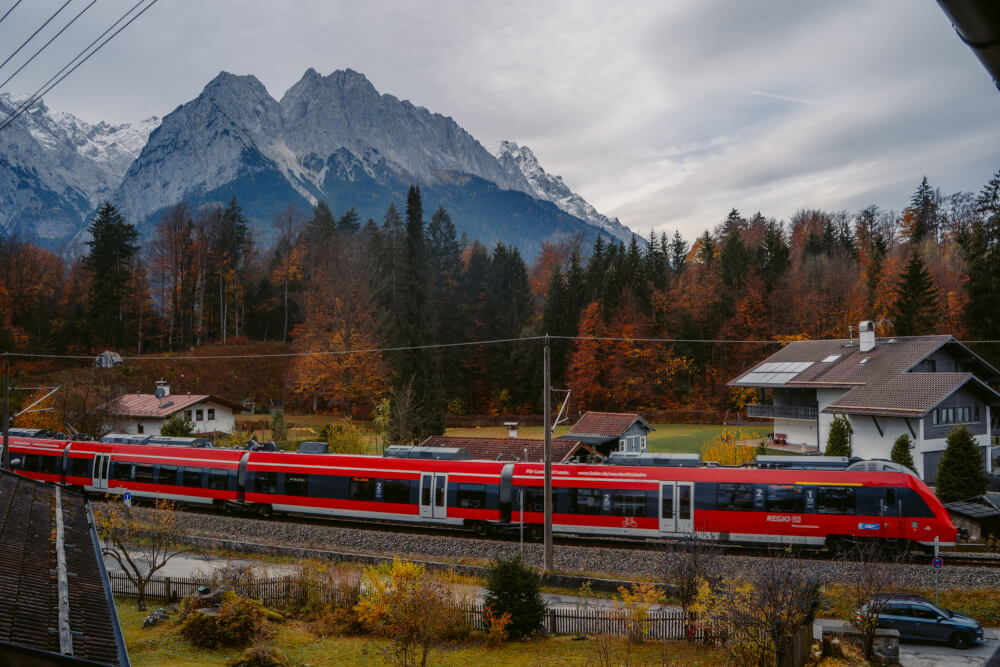
Another train operator you can consider in Germany is FlixTrain.
I’ve personally never taken them because in the time I lived in Germany, they were operating really limited routes and I still haven’t had a chance to try them. That said, their value proposition is super cheap fares starting at only 4.99 euro so definitely worth looking into if budget is a priority.
Flixtrain is fairly no frills – they only have one standard class and the buying process is straightforward so the rest of this post will focus on Deutsche Bahn trains and tickets.
NOTE: If you do book with Flixtrain though, be sure to double check that you are in fact booking a train, because this company also owns Flixbus, one of the biggest bus companies in Europe, and they’ll often show you buses alongside trains.
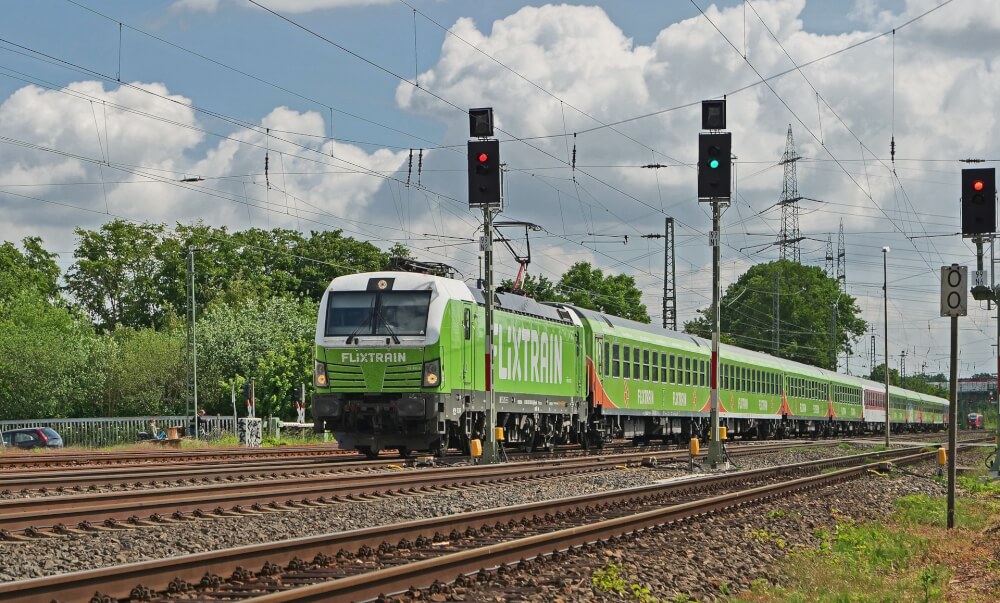
Now, let’s discuss…
Types of Trains
Broadly speaking, we can divide German trains into two three categories: long distance, regional, and local, such as S-Bahn or U-Bahn trains.
Understanding the difference between these is important, as they make a huge difference in journey time and cost, so I’m going to run through the most common ones, along with their abbreviations that typically show up in the train numbers and booking portals.
Long distance trains in Germany are used to connect larger cities and are therefore usually quicker, but typically require booking in advance, with reservations being a good idea in busy periods.
Under the German long distance train umbrella, we have…
- ICE: InterCityExpress trains, which are the fancy, high speed trains that get you between major cities, and can go up to 300km an hour. Especially quick are the ICE Sprinter trains which make even fewer stops than normal.
- IC: Intercity trains, which also travel between cities in Germany but are sometimes a bit slower than the ICE ones (maxing out at about 200km an hour) and often not as new or nice.
- EC: Eurocity trains, which travel between cities in Germany and elsewhere in Europe. These can look different than usual Deutsche Bahn trains because depending on the route, they may be operated by another country’s rail provider.

In contrast, regional trains cover shorter distances, typically within one state or region.
Reservations and assigned seats are not possible for these trains, their prices are fixed so buying in advance isn’t necessary, and they’re covered by a range of special deals which I’ll go over later.
Under this regional train umbrella, we have…
- IRE: Interregio-Express trains, which travel longer distances between regions but usually at much slower pace than the long-distance trains (and are therefore classified as a regional train as far as special deals are concerned)
- RE: Regional Express trains, which connect destinations in one region, but don’t stop at every stop on the route which can be faster than the…
- RB: Regional Bahn trains, which connect destinations in one region and do stop at every stop along a particular route
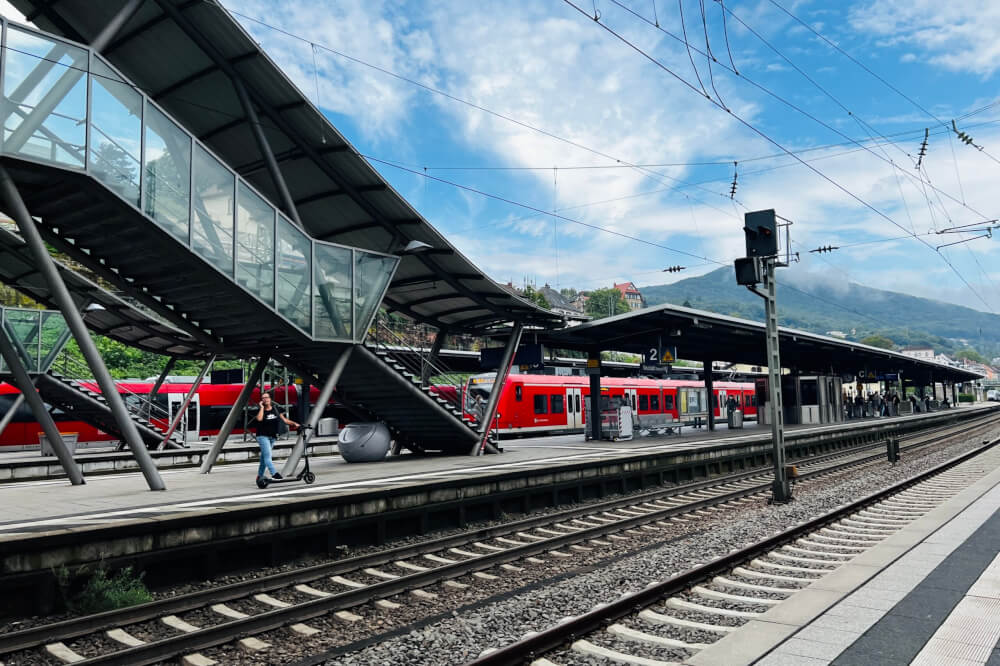
Lastly, on the local train front, we have options like…
- S-Bahn, which are trains that connect stops within cities and out to nearby suburbs, as well as…
- U-Bahn (in some cities) which are underground trains that connect stops within the city itself like the Subway or Metro
These are also typically covered by the special deals we’ll be discussing below.
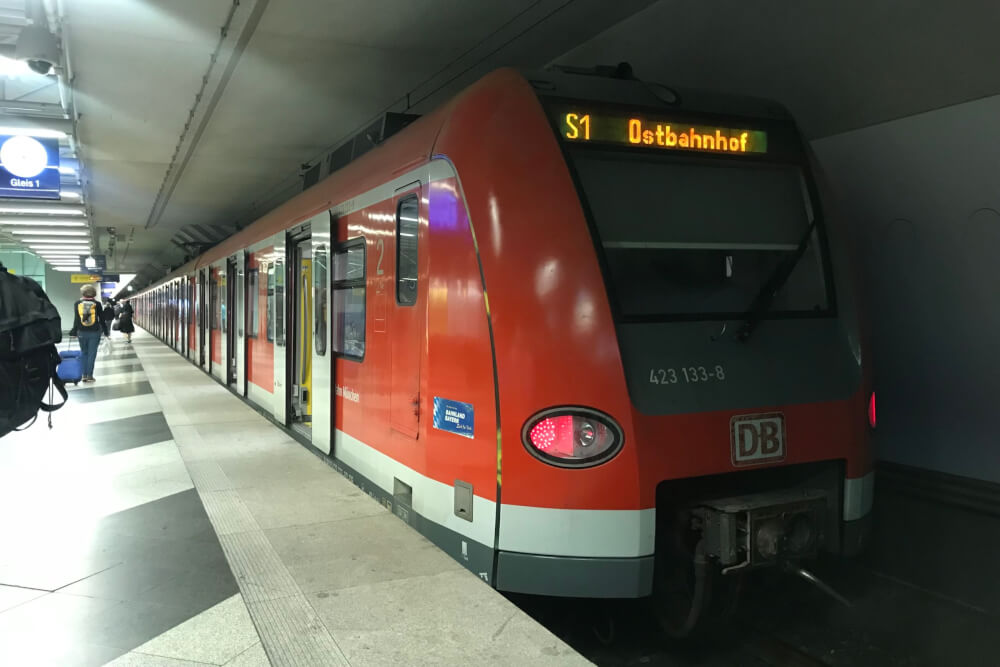
Now, with the basics covered, let’s go through step by step how to plan a train trip in Germany.
Step One: Decide if Train Travel in Germany is Right for You
First – let’s talk alternatives to train travel in Germany.
I’m a huge fan of German train travel, but there are other options for getting around that may be better suited to your specific trip and priorities.
Overall, I think taking the train in Germany is great if you’re looking for convenience, comfort and scenery.
The downside is however it can be quite expensive, especially if you don’t book in advance. It’s also not super convenient if you’re travelling with a lot of luggage (more than one big suitcase per person).
A more budget-friendly alternative may be taking buses, booking a ride share on services like BlaBlaCar or sometimes even flights if you’re booking with budget airlines like Ryanair, easyJet and Wizz Air.
Or, if your priority is freedom and getting off the beaten path, it may be worthwhile to rent a car.
Overall, if you’re torn and want to compare all your options at a glance, Omio is a great app that shows you planes, trains, and buses from Point A to Point B. From there, you can gauge whether train travel suits your needs.
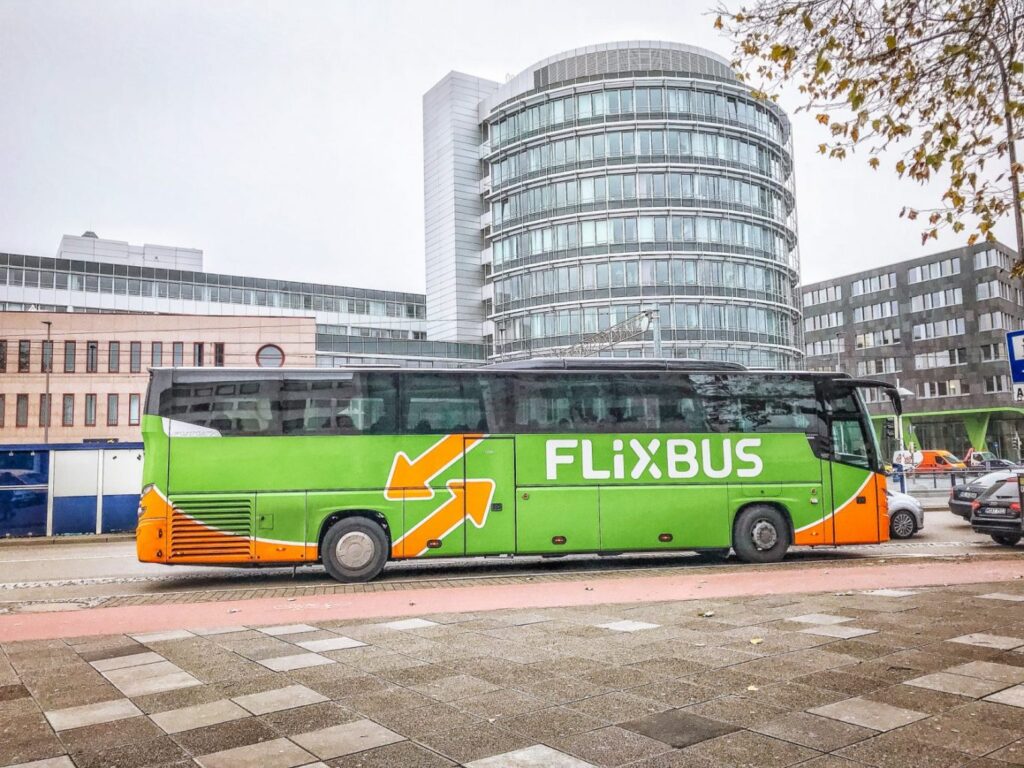
If/when you’ve decided you do indeed want to take the train, then we move onto…
Step Two: Buy Your Germany Train Tickets
The pricing of trains in Germany is dynamic, meaning the cost changes depending on when you buy it and what demand is like.
It is totally bananas to me that a ticket, when booked early, can be 20 euros but if you wait until the day before/day of it can go up to 180 euros.
But alas, I do not make the rules. If I did, everyone would get a free on-board puppy.
In any case, I’d advise booking tickets in advance online, because buying them on board isn’t usually possible, and buying in person from the information desk at the station does incur an extra service fee.
You can also buy tickets on machines at the station but I feel like this adds an extra element of stress, so be sure to book in advance whenever possible.
Now, there are a lot of considerations to be made when you go to buy train tickets in Germany. I’ll outline them all now.

First off…
BahnCard vs No BahnCard
If you plan to stay a while and take a lot of trains in Germany, it may be worthwhile to purchase something known as a BahnCard.
These are cards that you purchase for a set fee that then give you discounts on most train journeys, either 25% or 50% depending on which one you buy.
While these cards are definitely more geared towards locals than tourists, sometimes the discounts can be so significant that you can make the cost up in just a few journeys, so it’s worth crunching the numbers.
Especially interesting for short term visitors are the Probe Bahncards, or Trial cards which allow you to buy a cheaper membership that’s essentially a trial for 3 months, rather than for a whole year.
These start at just 17.90 for the three months, an amount you can easily make up if you’re buying an expensive long-distance or last minute ticket. Just don’t forget to cancel your subscription 6 weeks before the expiry date, or it auto-converts to an annual one that of course costs more.
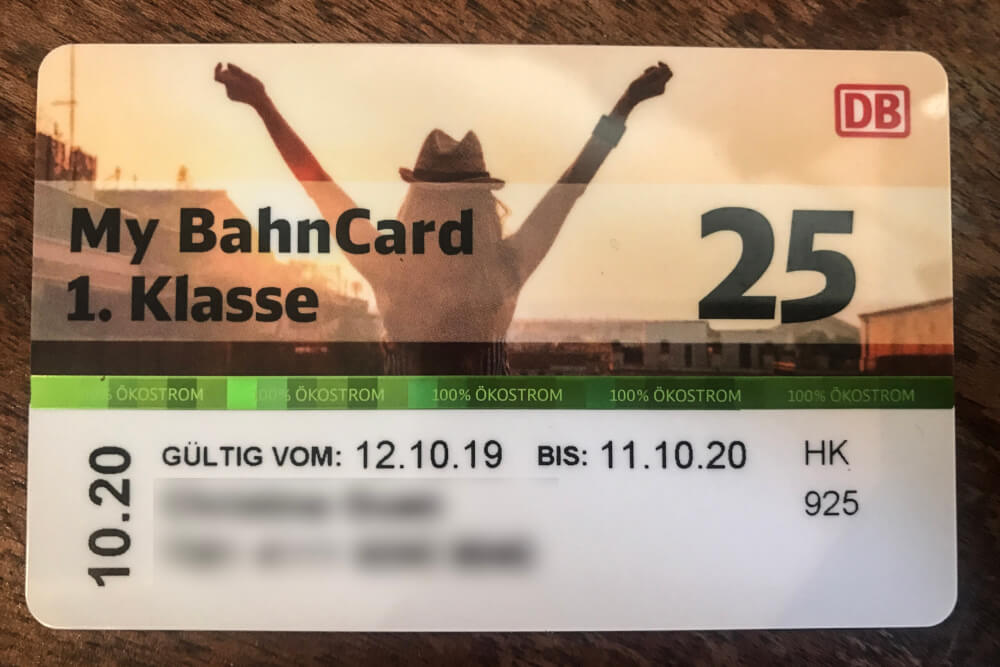
Honestly though, for most tourists visiting for a short time, there are better ways to save money on German train tickets.
So let’s move onto our next consideration which is…
Standard Tickets vs. Special Tickets or Rail Passes
If you are only booking a few train journeys during your time in Germany, the best option is most likely to just buy tickets for the journeys you’re taking, meaning hopping on the Deutsche Bahn app or website, entering Point A to Point B and buying tickets for each trip you plan to take.
Sometimes though this won’t be the way to get the best deal. So, I’m going to outline some options that may save you money depending on your circumstances.
First off – do know that there are age based discounts on Deutsche Bahn for the following groups:
- (FREE!) Children 6 & under
- (FREE with parents or grandparents) Children aged 6-14
- Youth (aged 15-26)
- Senior (age 65+)
So, to activate these discounts, be sure to specify your age and the age of those travelling with you when you go to search routes.

Now, if you are looking to save money on regional and local trains in Germany, there are few excellent options that are almost guaranteed to save you money, especially for day trips.
With one of these, you can genuinely save hundreds of euros over buying individual tickets the day-of.
If your travels are restricted to one German state, then look into buying a regional day ticket (known in German as Länder-Tickets). These give you unlimited travel on regional trains for one day, with options up to five adults on one ticket.
The savings with these are also better the more people you bring, with a base fee, then a small additional fee for every extra person, so definitely worth considering if you’re travelling in a group.
Here are the different regional tickets you can buy:
- Baden-Württemberg-Ticket
- Bayern-Ticket
- Brandenburg-Berlin-Ticket
- Hessen-Ticket
- Mecklenburg-Vorpommern-Ticket
- Niedersachsen-Ticket
- Rheinland-Pfalz-Ticket
- Saarland-Ticket
- Sachsen-Anhalt-Ticket
- Schleswig-Holstein-Ticket
- SchönerTagTicket NRW
- Thüringen-Ticket
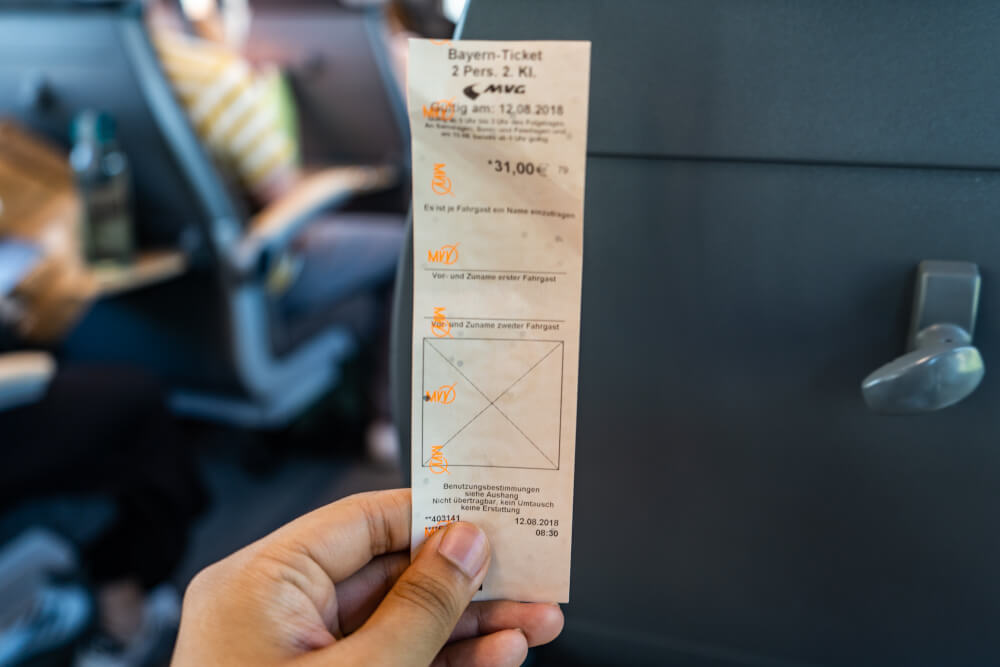
They also have a Germany-wide version of this ticket if you plan to travel across states, known as the Quer-durchs-Land-Ticket.
BUT, an even better deal if you plan to use regional trains exclusively across Germany is a relatively new offering known as the Deutschland ticket.
This golden ticket is only 49 euro a month and gets you unlimited travel on regional trains for that whole month. Considering a one-day Quer-durchs-Land Ticket is already 44 euro, getting the Deutschland Ticket is pretty much a no-brainer if you’ll be taking regional trains for more than one day.
BUT the catch is, this ticket is more geared towards locals, and therefore is offered on a subscription basis. So long as you cancel your subscription in time though, then you can easily just use it for one month or as you need.
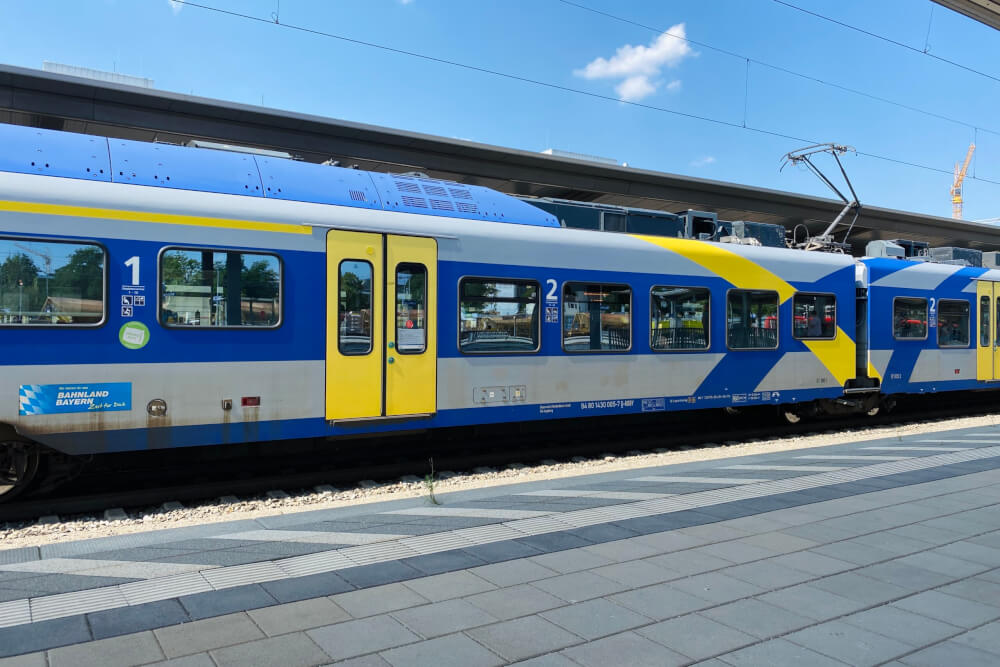
Unfortunately, saving money on long distance trains is less simple. Generally, your best bet is just booking early. The earlier you book, the cheaper it’ll be.
If you can’t book in advance though, a potential cost saver could be a rail pass.
If you are just travelling within Germany, there is a German rail pass you can buy for unlimited journeys either on a flex basis, meaning for a few days within a set period or on a consecutive basis, meaning a set number of days in a row.
If you are travelling to other countries in Europe, it may be worth getting a Eurail pass, also known as an Interrail Pass when you’re a resident of Europe.
Used properly, these passes can save you a lot of money, but only in certain situations so for more information on that, be sure to read my full Eurail review.
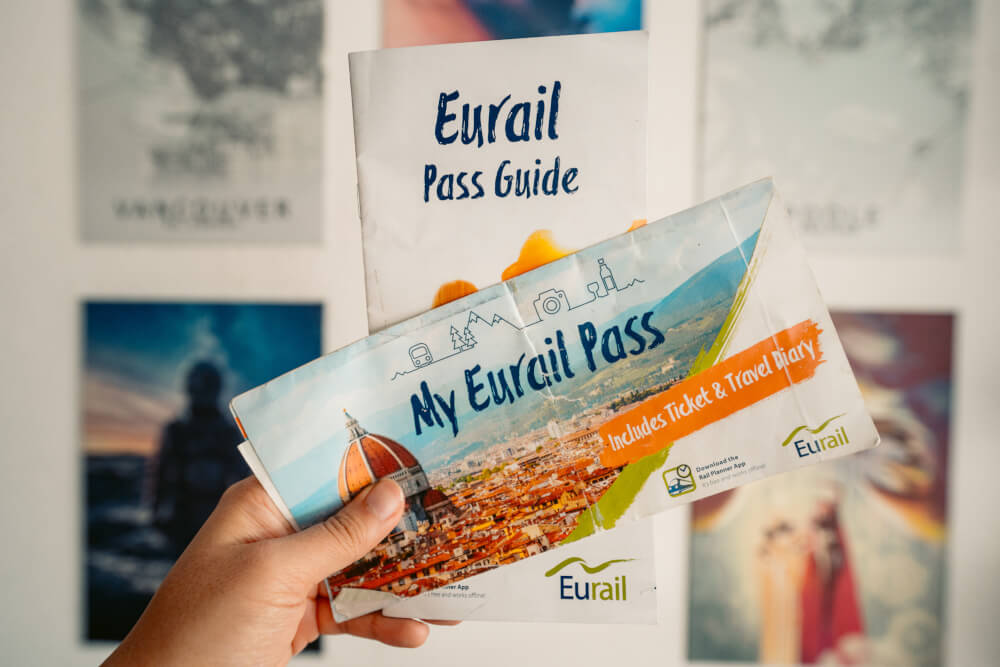
Now, when you go to buy tickets, you can either do so in person or online.
Online, you can either buy tickets directly through Deutsche Bahn (website or DB Navigator app) or through a third party website.
Booking direct with Deutsche Bahn will pretty much always be the cheapest option, but if you’re planning a big trip with lots of trains or buses in other countries, then a 3rd party like Omio or Trainline might be worth it just to keep all your tickets in one place.
NOTE: When choosing your journey, always prioritize direct connections or routes that make fewer stops. These will usually cost more, but trust me, it’s worth every penny! Transfers are simple enough when trains run on time, but as soon as you’re hit with a delay, that can disrupt your entire journey and make things 100x more stressful.
Whether you buy from Deutsche Bahn or from a third party though, there are several considerations to make, so I’ll run through them now.
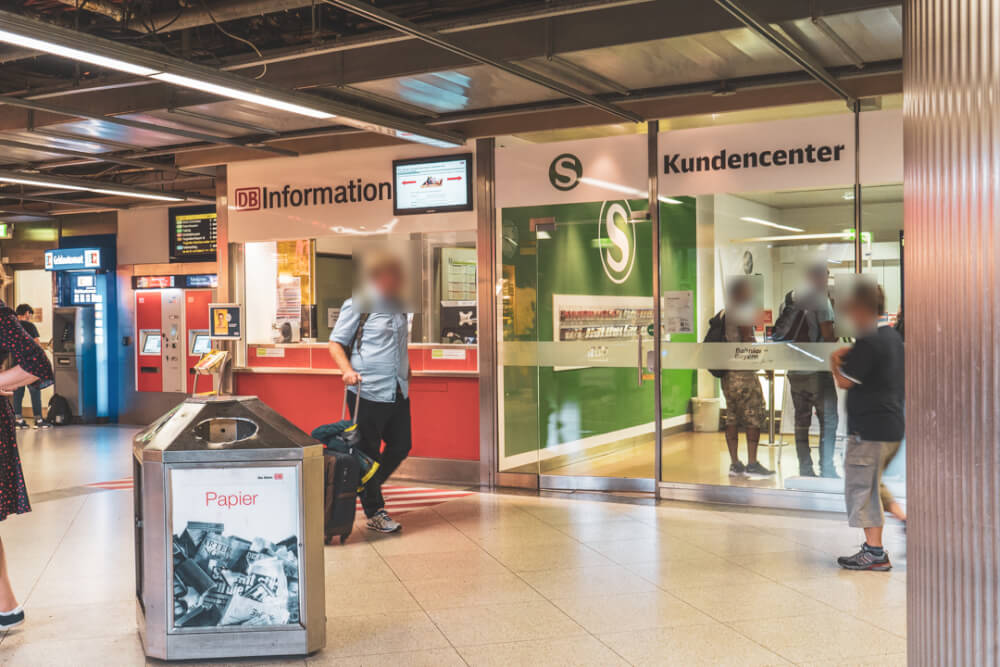
Firstly:
1st vs 2nd class on German Trains
The first time I got to sit on a 1st class German train, I had extremely high expectations.
Part of my brain flashed to a sepia-toned flashback of glamour train travel in the 60s, with fizzy champagne flowing and a steak dinner served right to my seat. I knew this wasn’t going to happen, so I dialled it down. I once took a first class train in Italy and they gave us coffee and snacks. I therefore looked forward to said coffee and snack.
German trains? You get pretty much nothing. So no, the difference isn’t stark, but there are some instances where I think splurging on first class is worth it.
On regional trains, there isn’t a dramatic difference between first and second class seats.
The main perk is it’s generally quieter and sometimes the seats are slightly comfier. So, I would go for first class in regional trains if a) the price difference isn’t much/doesn’t matter, b) you want extra privacy or c) it’s a busy time and you want to secure your chances at having a seat (and space for your stuff).
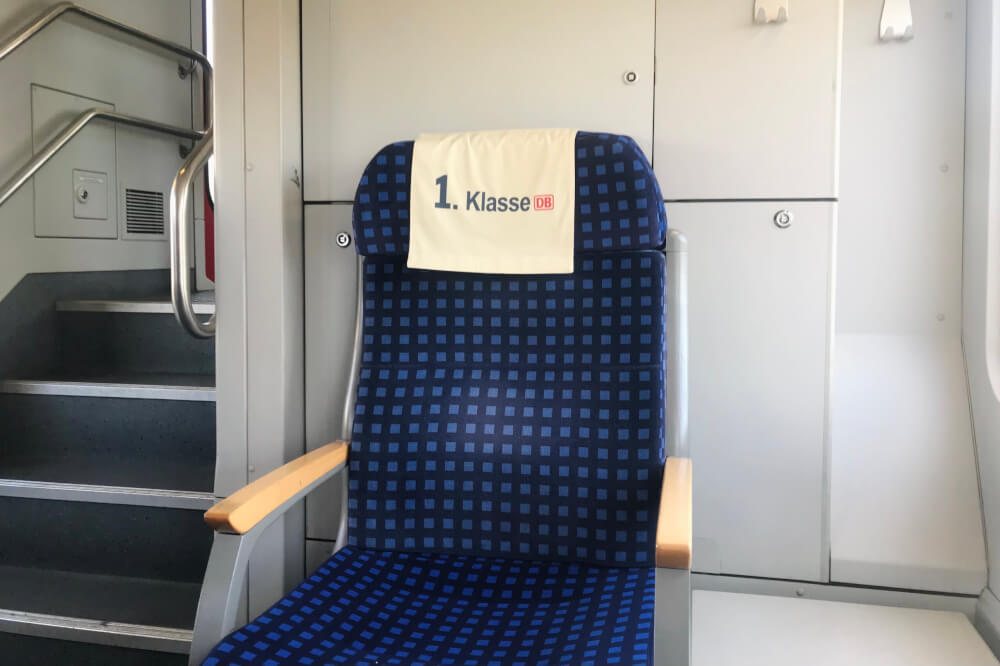
On long distance trains however, there’s definitely a bigger difference between first and second class, especially on ICE trains.
In first class, the seats are more comfortable, a reservation is included, you can get food/drinks ordered to your seat, and for introverts like me, there are even single seats you can reserve so you don’t have to sit next to anyone.
If any of these perks sound appealing to you, then I’d say it’s worth the extra cost (which is sometimes minimal if you book early enough).
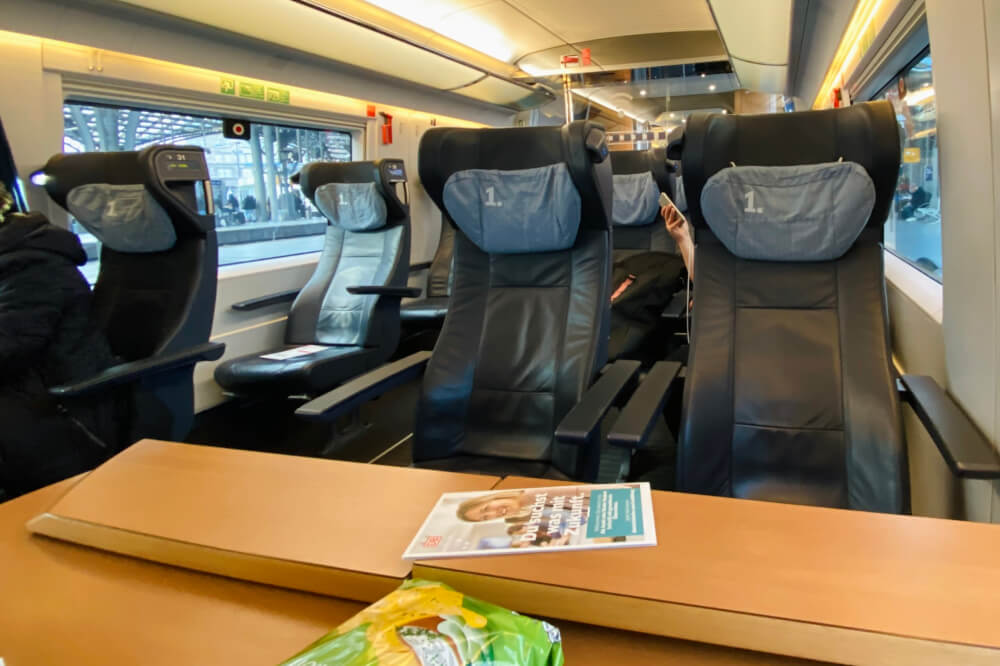
The next consideration is…
Reserved vs. Unreserved seats
Reservations are pretty much never mandatory on German long distance trains, and aren’t even possible on regional trains, S-Bahn or U-Bahn.
That said, I would highly advise making a reservation if you’re at all an anxious traveller, or if you’ll be travelling during a busy period.
The cost is only about 5 euro and having that peace of mind for me is more than worth it.
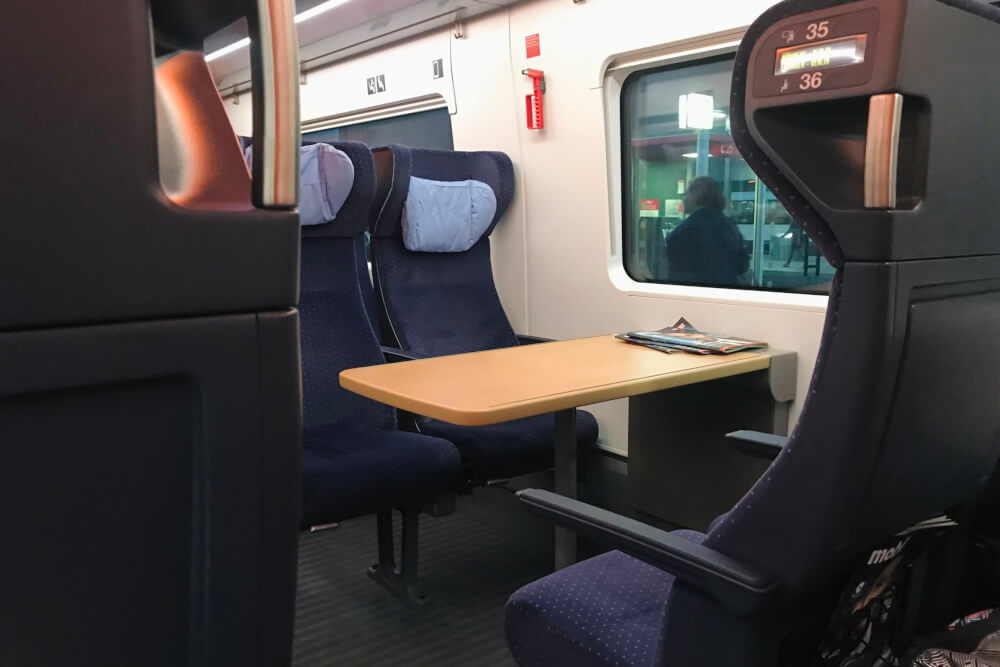
If you do end up reserving a seat, another consideration is…
Carriage and Seat Types
Some trains in Germany have different carriages intended for different purposes, such as…
- Silent/quiet carriages
- Cellphone carriages (where you can freely make calls)
- Family areas
- Bike zones (with additional space)
- Accessible zones
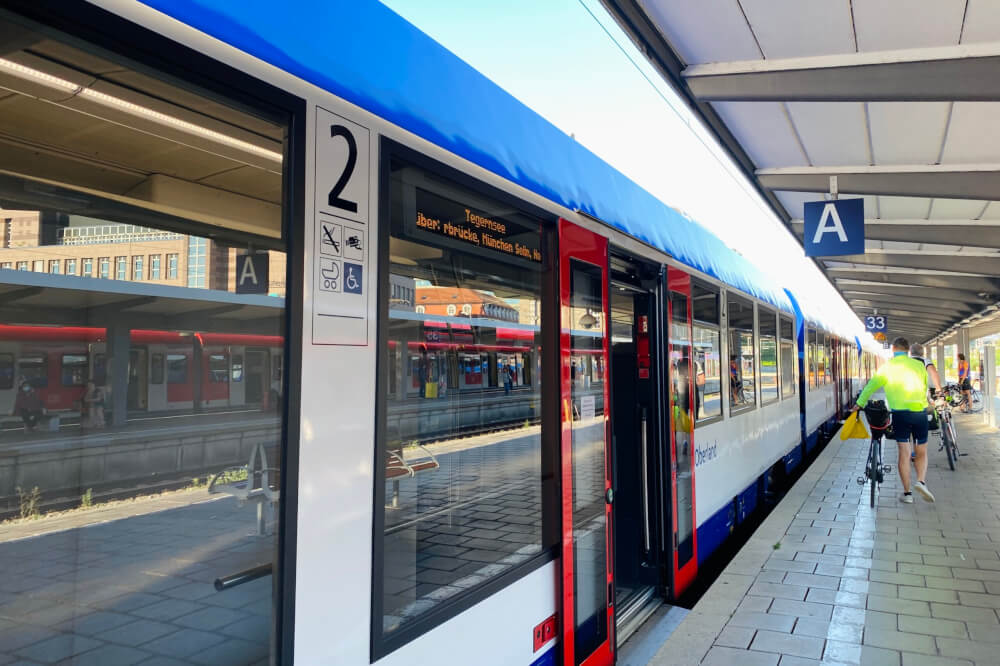
There are also different seating configurations for many long distance trains, with the two main choices being:
- Open saloon seating, which is your standard train set-up with seats in a carriage, sometimes with a table around which 4 people can sit facing each other OR
- Compartment seating, which are more old school closed compartments with seats facing each other. These are fun if you get them to yourself, or with your own group but can be a bit intimate if you’re sharing with strangers
You’re usually given an interactive map when you book a reservation, so you can also make other considerations like window vs aisle or how close you are to amenities like the bathroom, luggage racks or the on board restaurant.
Be sure to take some time to consider which seat you might want to reserve – not all seats are made equal!! With seats at the end of cars for instance, people will be coming in and out constantly to go to the bathroom, which isn’t ideal if you’re looking for a peaceful journey.
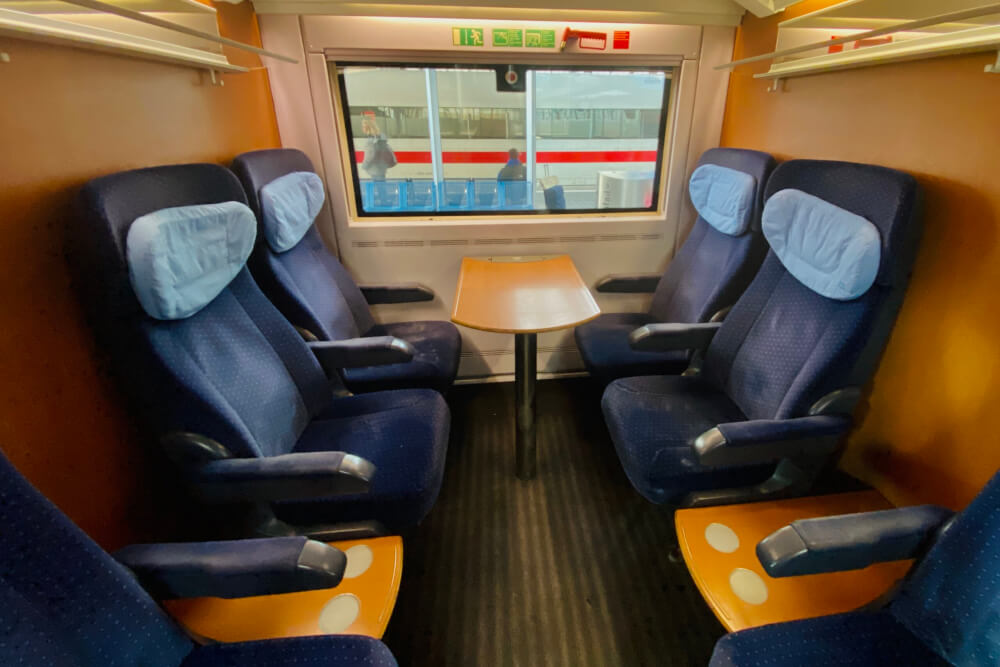
Another choice you’re given when buying tickets is…
Flexpreis vs Sparpreis
Essentially these are different versions of the same ticket, and make no impact on the destination/route, but do impact how flexible the terms of your ticket are.
The Sparpreis is essentially a ticket that is only valid for that one train and time you’re booking. In exchange for this lack of flexibility, the fare is much cheaper, especially with the Super Sparpreis (which is most limited in flexibility).
In contrast, the Flexpreis ticket gives you a lot more flexibility, usually allowing you to travel on any train that day for your chosen route, or with the Flexpreis Plus, even trains the day before or two days after.
Overall, I feel like the price difference is rarely justified for these Flexpreis tickets (sometimes it’s more than 5x!), but do what’s right for your own trip and priorities.

Lastly, there’s…
Bike/Pet Add-Ons
If you are travelling on German trains with a bike or with a pet, know that you’ll typically need to buy an additional ticket for them.
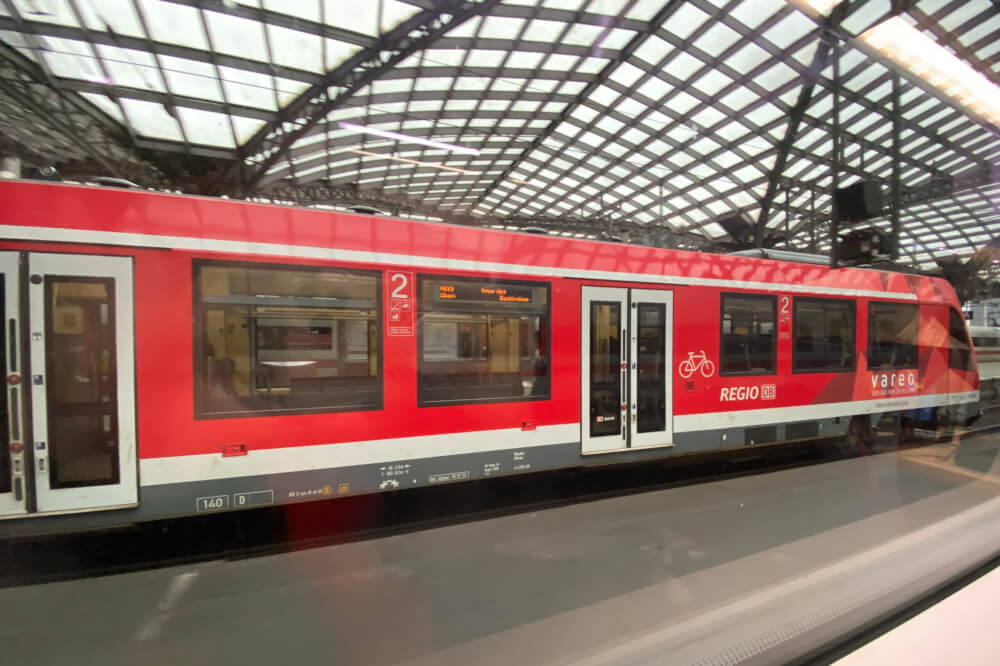
Alright with your tickets booked it’s time to move onto the day of your journey, with…
Step Three: Get Snacks
On the day of your journey, I highly recommend you get some food and drink to bring with you on the train (especially for longer trips). This is completely allowed on German trains!
While there are usually some food options on board with long distance trains, they tend to be fairly limited and pricey, so getting your own gives you more control. On regional/local trains, there is no food or drink sold on board at all.
So, at the very least, I’d get some water or something to drink. There’s often great options even at the train station itself.

Now let’s move onto…
Step Four: Arrive at the Station
First off, before leaving, double check that you are headed to the right station. Many major cities will have multiple stations like Munich, which has its Hauptbahnhof (Main Station) as well as Ostbahnhof (East Station) and other smaller ones.
If it’s your first time at this station, and if you’re in a big city, I recommend you arrive thirty minutes or more in advance of your departure time, because main stations in cities like Berlin, Munich & Hamburg can be very overwhelming, with multiple levels, shops and 20+ platforms.
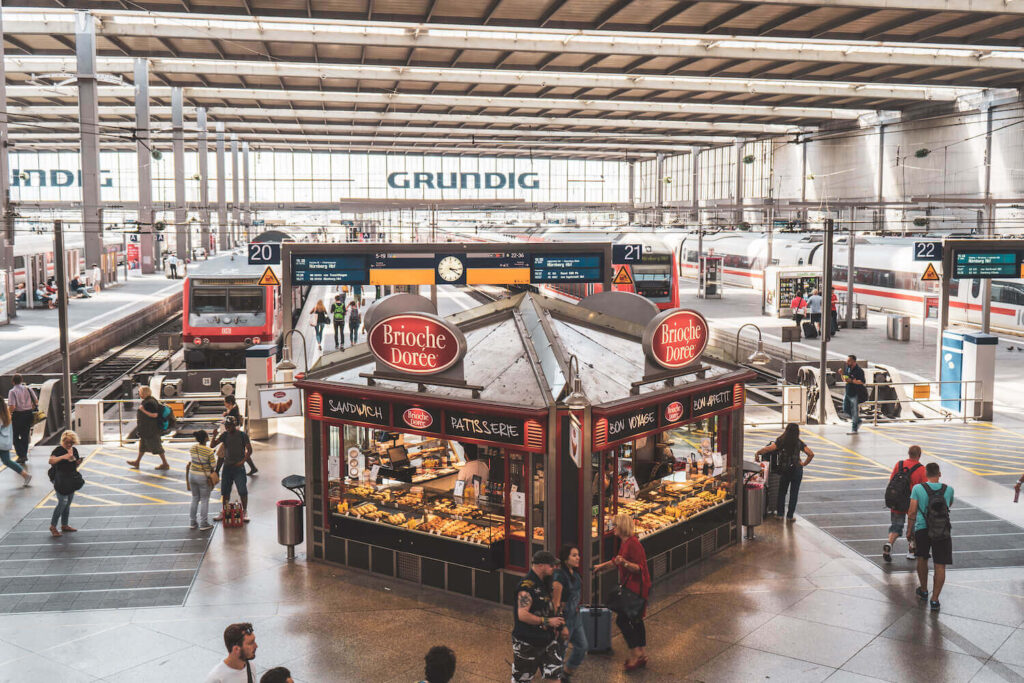
Now, if you are taking public transport and arriving at the train station in a big city, you might find it tough to find where the trains actually are, because often these stations are multi level transport hubs servicing U-Bahn, trams and buses as well.
In any case, all you need to do is look for train symbols on signs like this which will point you in the direction of the platforms:
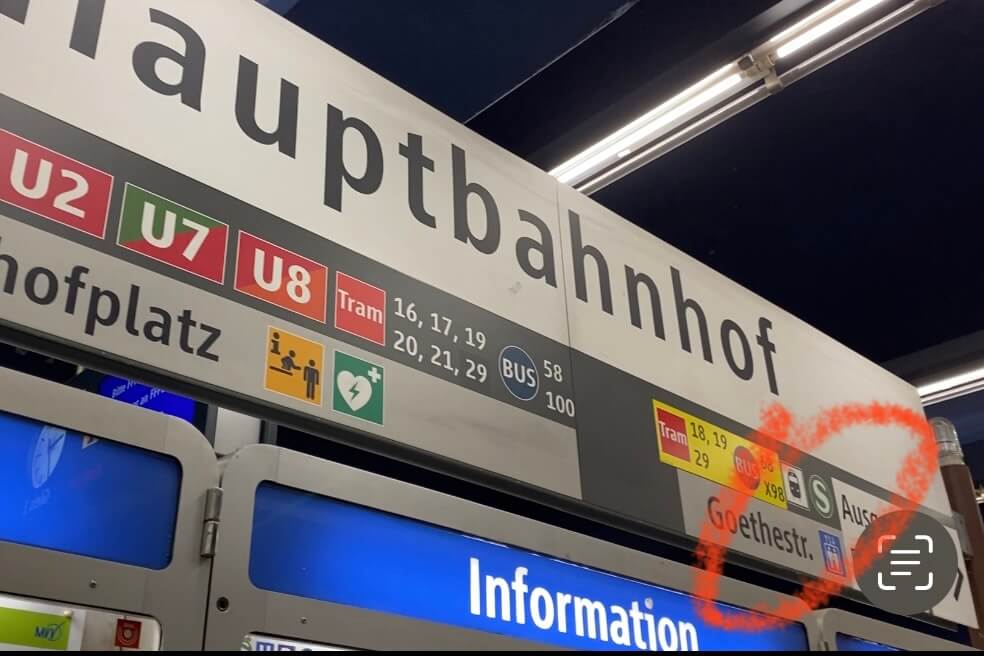
Now when you get to the station’s main concourse, your priority is finding out which platform your train is on. The Deutsche Bahn app will usually tell you in advance but I like to double check on the board just in case.
When looking at the board, remember that trains will not necessarily say your destination, but rather the final destination of the train, so if you don’t see the name of where YOU’RE travelling to, don’t panic.
Look for the time and train number, and (when available) the list of stops to see if your destination is listed, then figure it out from there. Beware that some cities like Munich and Cologne have a different name in German (München & Köln) and that’s likely the name that will show.
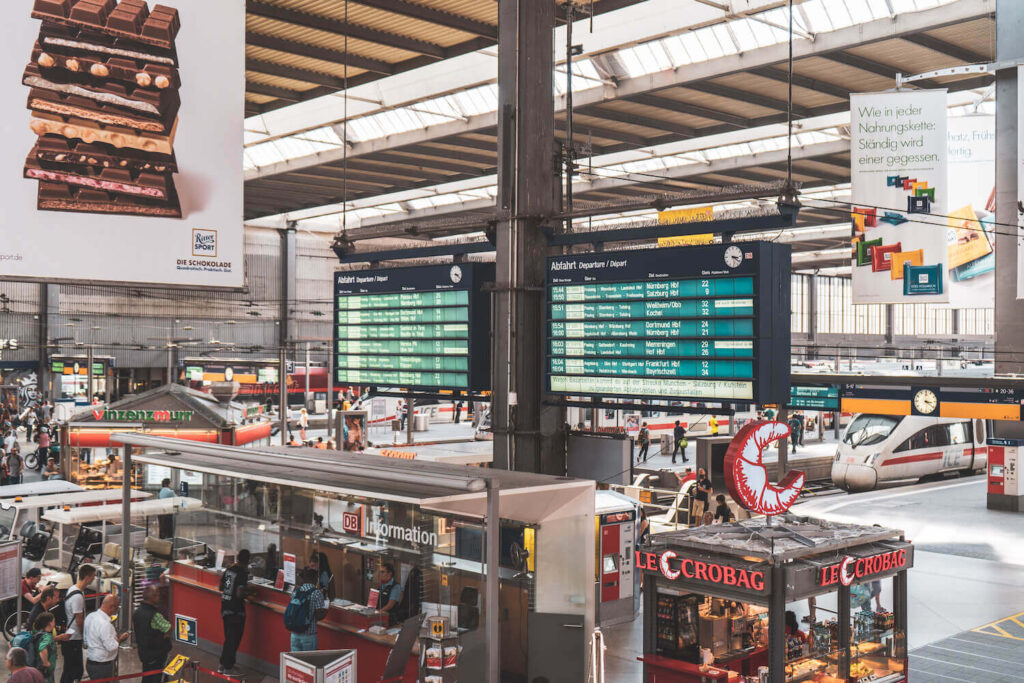
Next, it’s time to…
Step Five: Get to the Platform
Platform numbers will generally be very well marked so just look up for signs before making your way.
You will not need to have your ticket for this part, because there are no fare gates for German trains, and tickets are usually just checked on the train itself.
When you get onto your platform, double check it’s correct by confirming either on a platform screen or on the side of the train that you’re in the right place before proceeding to find your carriage.
NOTE: Some regional trains in Germany are divided trains that split at one point in the journey, which means only certain cars end up going to certain destinations. So, before you board, double check that the destination on your train carriage is actually where you want to go.
In cases where the train splits, the sign will usually tell you which cars or which part of the platform to go to for your destination, so keep an eye out for that.
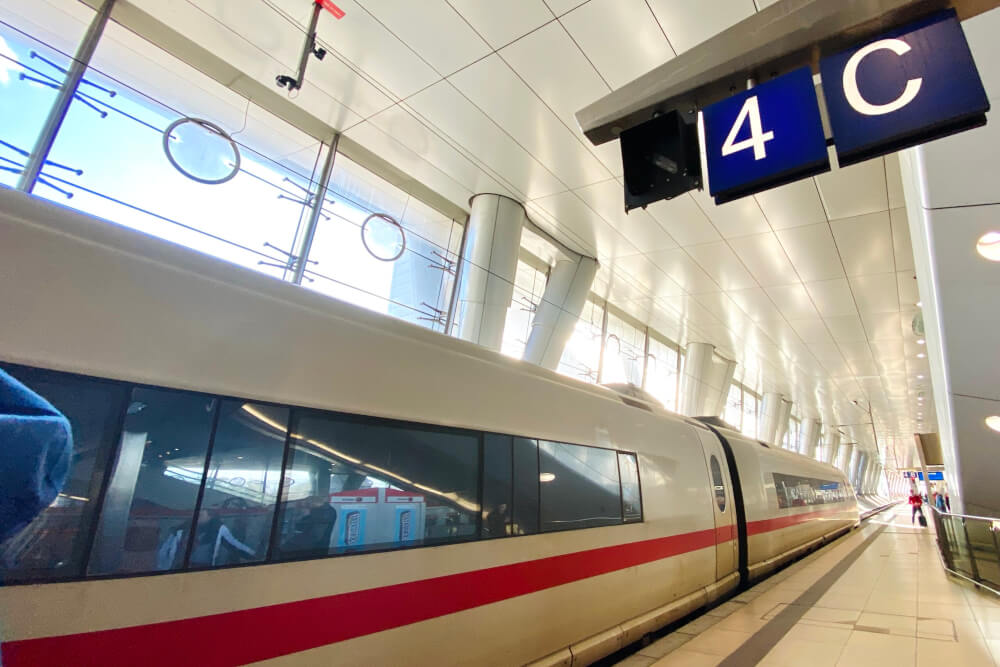
Next up, it’s time to…
Step Six: Find Your Carriage
If you have a reserved seat, then you’ll need to take some extra steps to make sure you get to the correct carriage once the train arrives.
German trains can be very long, so if you have a seat reservation, make sure you’re standing in the right part of the platform to get onto your carriage, otherwise you’ll have to awkwardly dodge and shuffle your way all throughout the length of the train.
With reserved seats, a handy thing to look out for are these charts that show you which part of the platform to stand on (marked by number/letter) depending on your carriage number.

If you do not have an assigned seat, then you simply need to board a carriage in the right class, then pick a free seat.
In these cases, look up at the platform sign and there should be a little diagram that explains which letter part of the platform to stand on for 1st class, 2nd class, and the meal car (depicted by a tiny knife and fork).
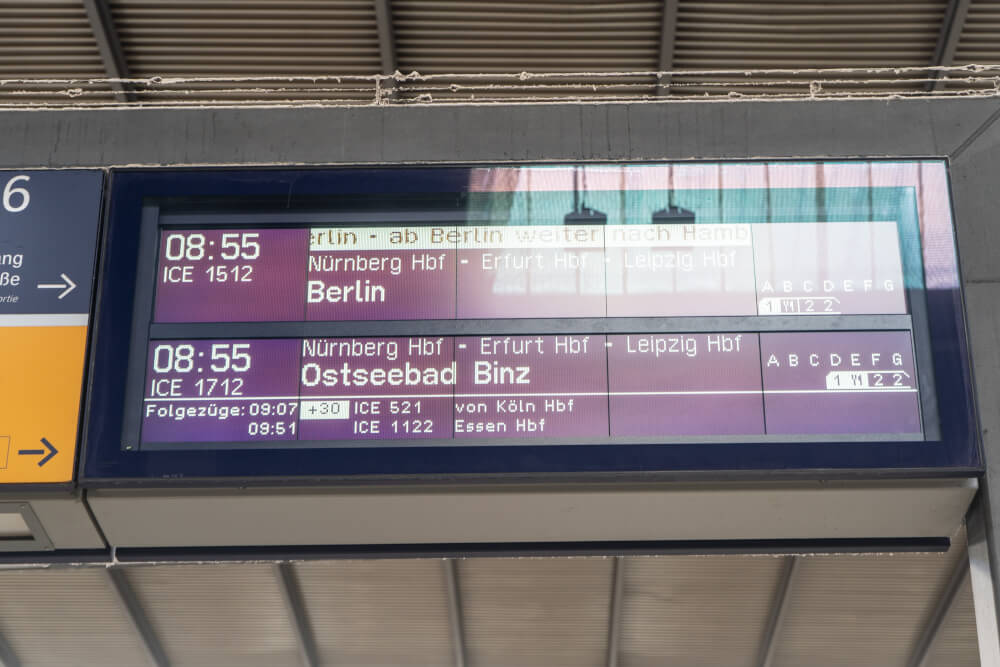
When picking a carriage to board, pay special attention to…
- The class number of the carriage (you may only board the class you’ve booked for)
- Whether they are special carriages meant for a certain purpose e.g quiet zone, bicycle zone
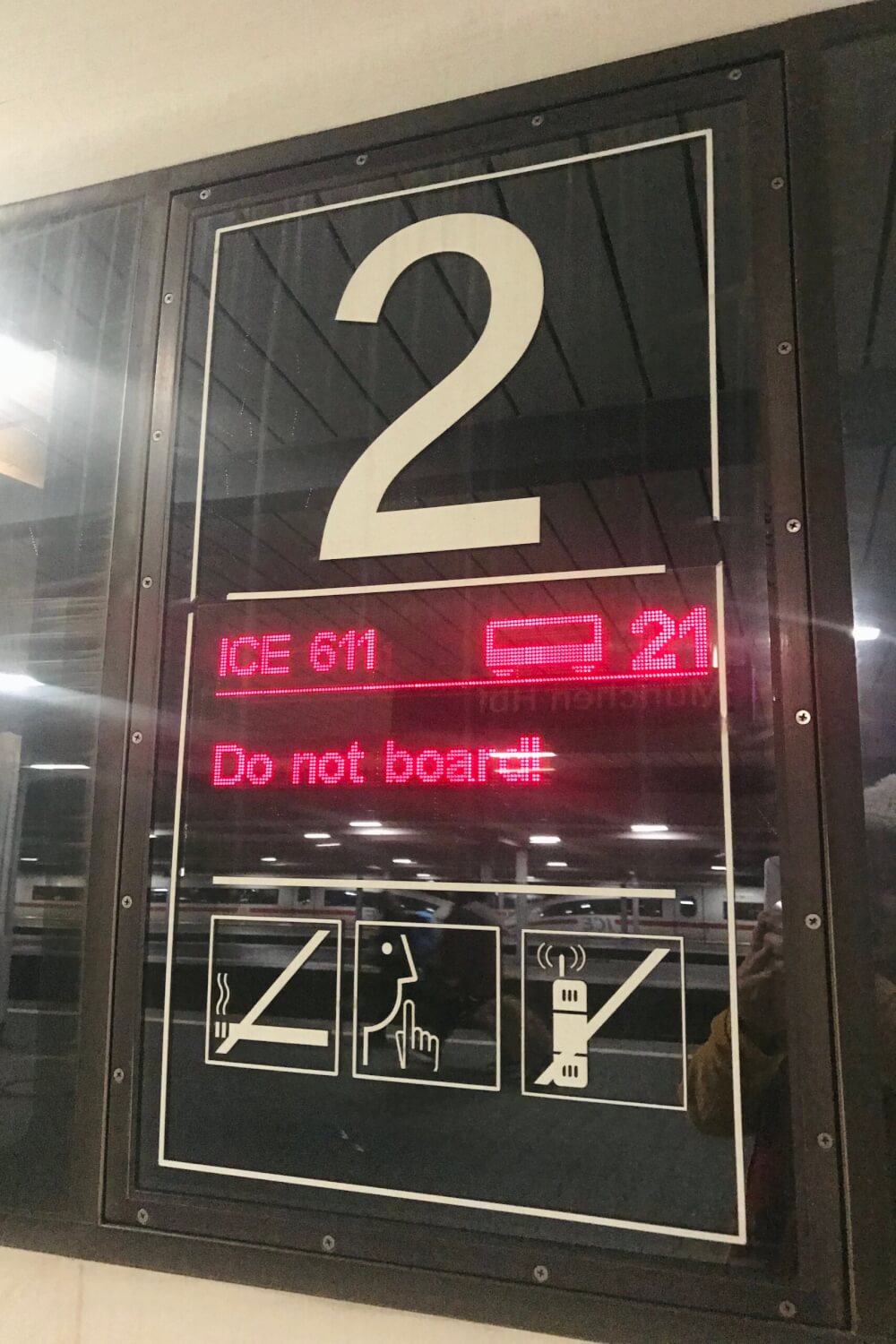
If you don’t have a reserved seat, then usually I find the farther you walk, the emptier the carriages will be.
Once you find or choose your carriage, then it’s time to hop on board.
If the door isn’t opening then look for a button like this <> and press it. This goes for the train doors as well as carriage doors.
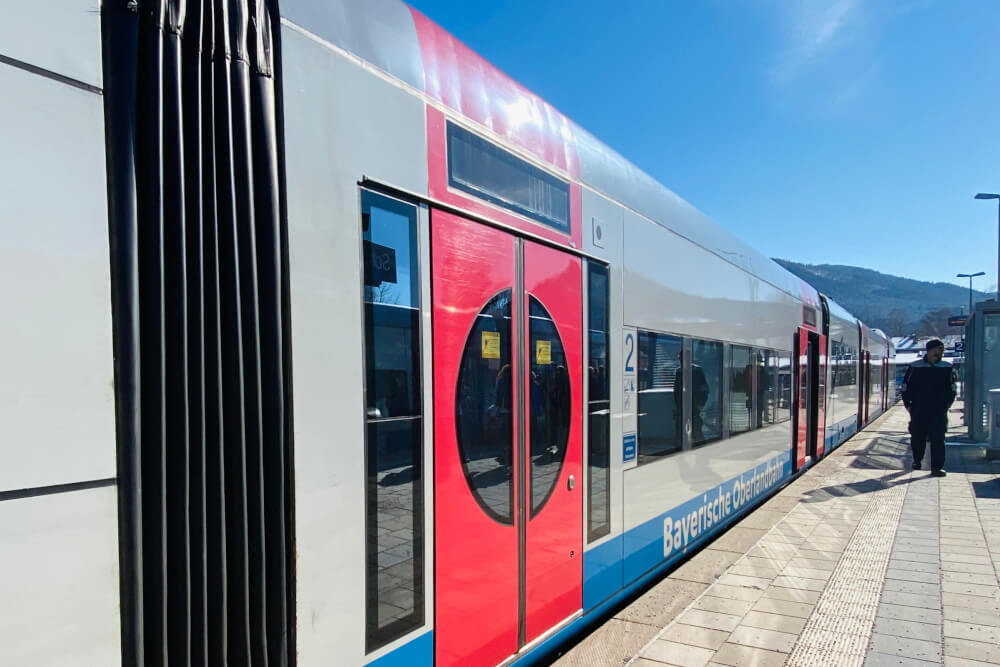
Now it’s time for…
Step Seven: Find Your Seat
First off, if your seat is assigned, try to make sure you go in through the correct door closest to your seat.
Long distance trains will usually write the seat numbers on the corresponding door, like so:
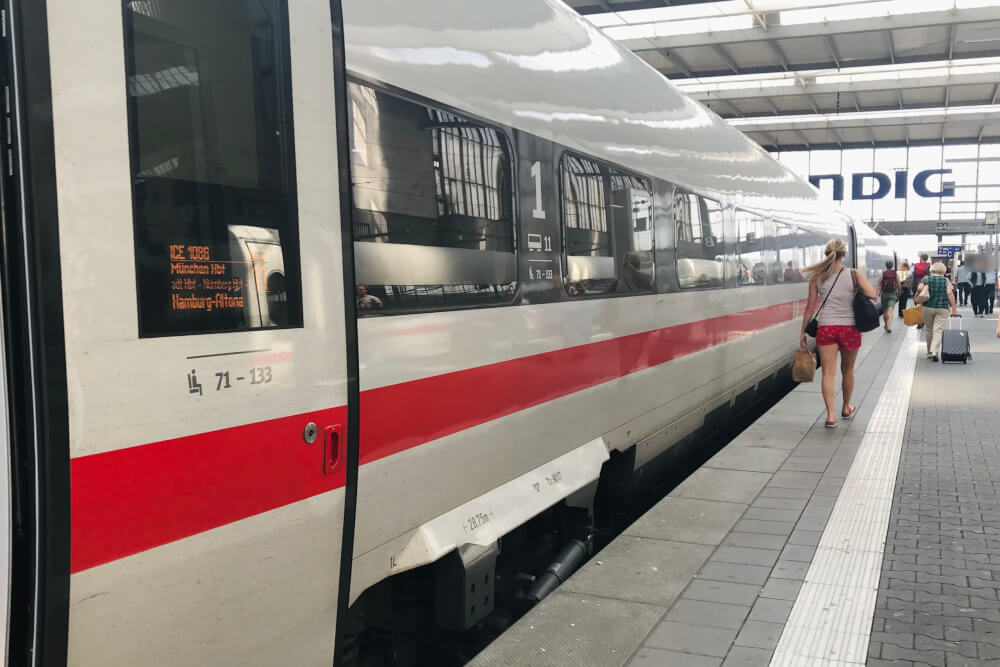
If you have large bags, keep an eye out for large luggage racks when you enter. These will usually be found on the ends of the carriages.
With smaller bags/suitcases, there is usually space above your seat for it, or sometimes under and between seats, as marked.
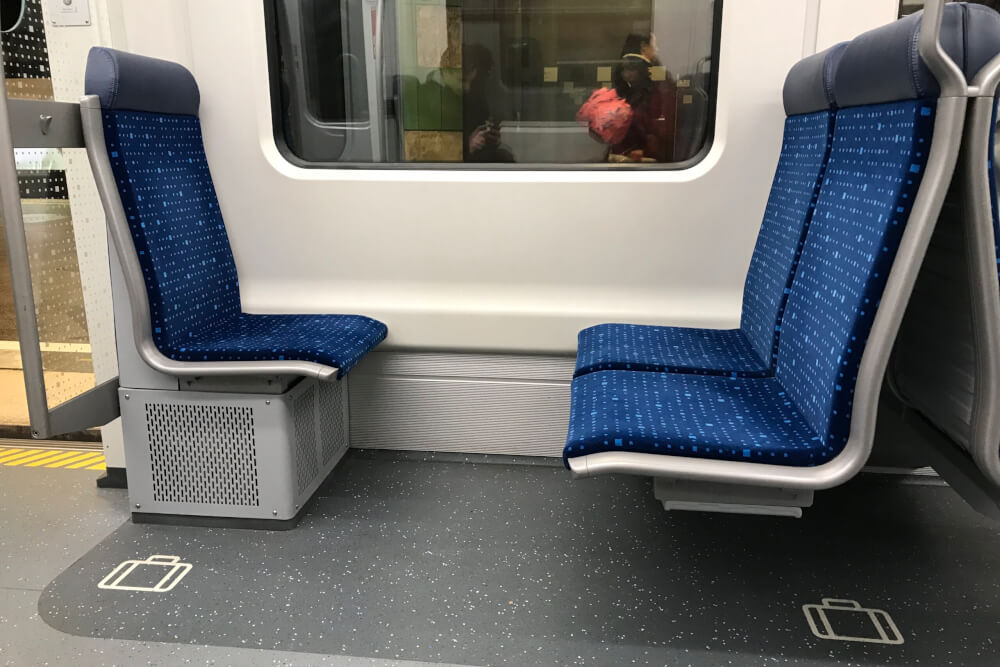
If you don’t have a reservation, before sitting down, make sure your seat isn’t reserved and make sure you’re not taking up a priority space if the train is looking full.
Seats that are reserved on long-distance trains will usually be marked on an electronic screen that shows you which part of the journey the seat is reserved for.
So let’s imagine you’re going from Munich to Berlin. The screen may show the seat is reserved for the whole journey, or for just a portion. If your journey doesn’t overlap with the reservation, then that sat is technically free.

But do note however that the screen may sometimes say something else like..
- ggf. reserviert (possibly reserved)
- ggf. freigeben (possibly to release)
Both of these annoyingly mean that the seat might be reserved, or it might not, but either way you have to vacate it if the person with a reservation comes, so you kind of just have to sit there and hope for the best.
It is honestly the silliest system. To avoid this Russian Roulette of seating charts, be sure to just reserve yourself a seat. It’s worth it.
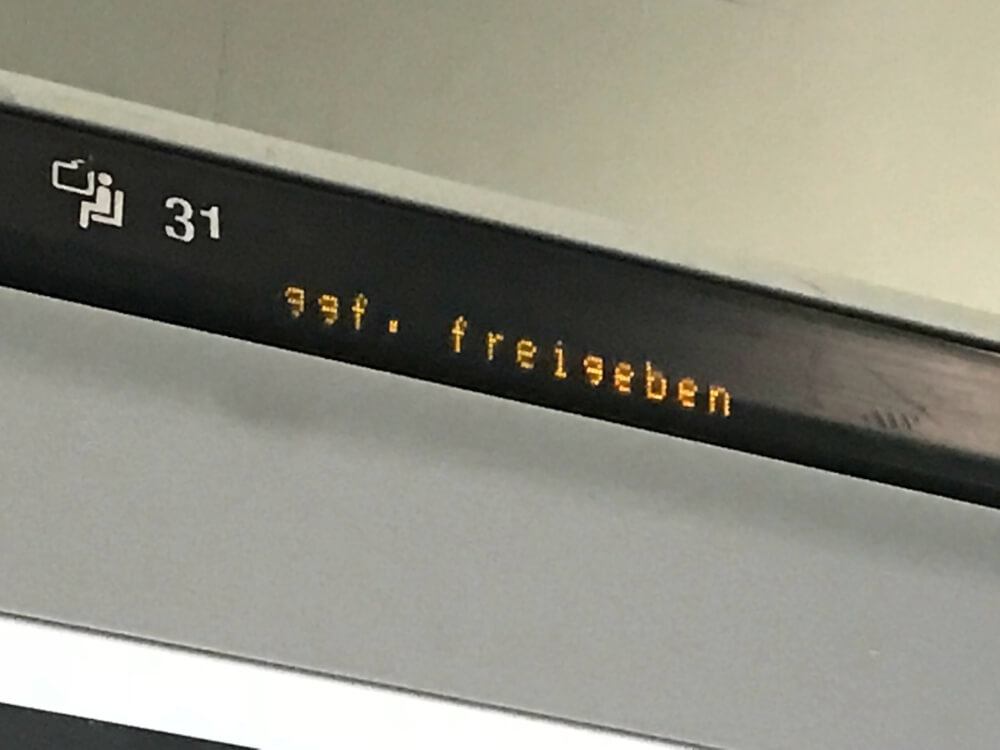
There are also some seats that are reserved for Bahn Comfort customers, i.e. VIP frequent travellers, so avoid those when you see them or an especially fancy-looking person might come kick you out of it.
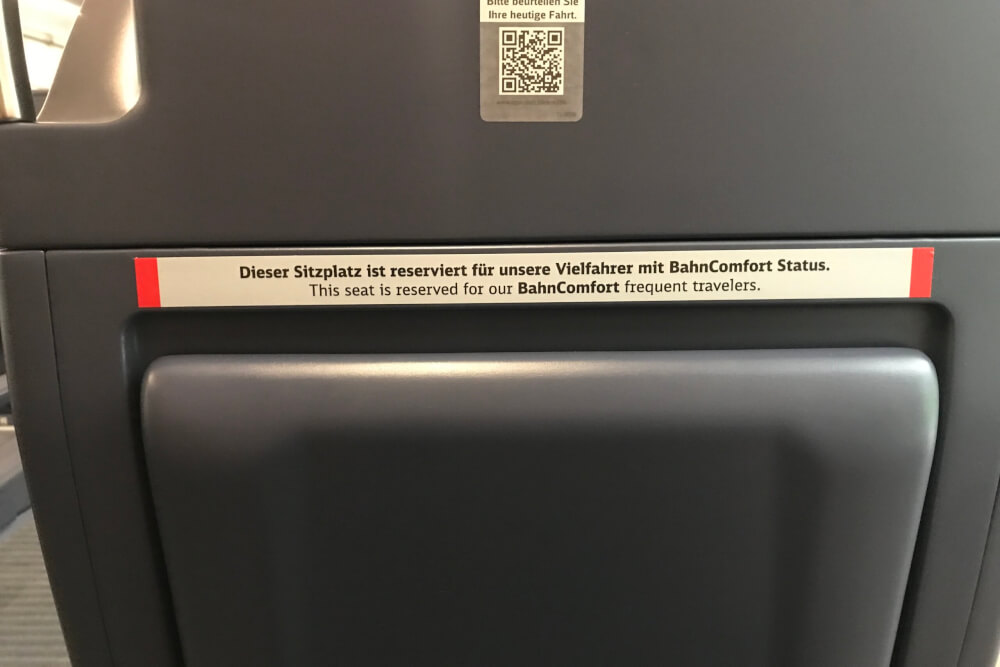
Now finally, onto…
Step Eight: Get Comfortable and Enjoy the Journey!
Once you’re all settled, you’re now in a good place to enjoy some of the hidden features and amenities of your train.
Okay, I say “hidden”, but what I mean is they’re easy to miss, especially if it’s your first time on board a German train.
So, be on the look out for…
Coat hooks: These can be found on the wall next to your seat – sometimes they may need to be pulled out. You can leave coats, scarves, etc. on those
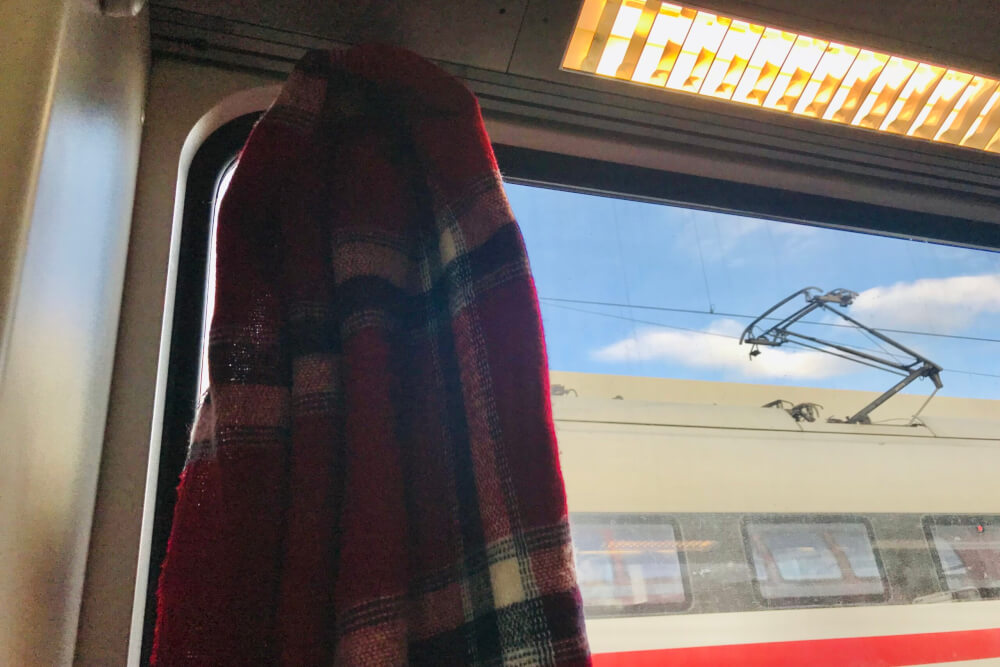
Plugs: Most trains will have an area to charge electronics. On ICE trains, usually the charging ports are in the middle part between two seats. On regional trains, the charging ports can often be found between seats or on the wall.
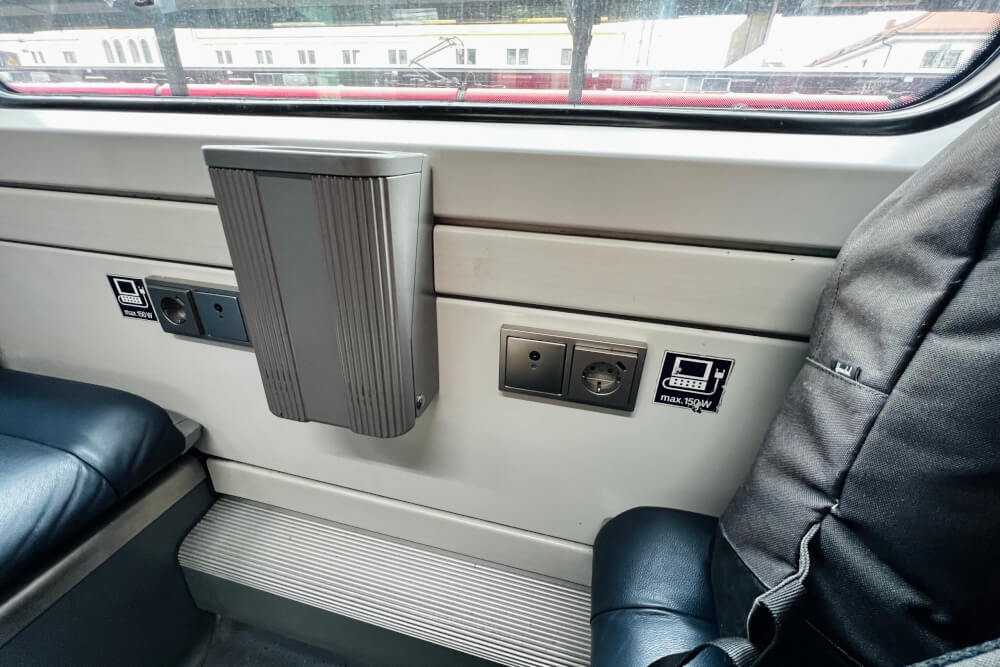
WiFi: Most long distance trains will say they have this but the quality is questionable depending on where you are. Many S-Bahn routes are starting to get WiFi too. Like with modern dating apps, be sure to try connecting, but don’t get your hopes up.
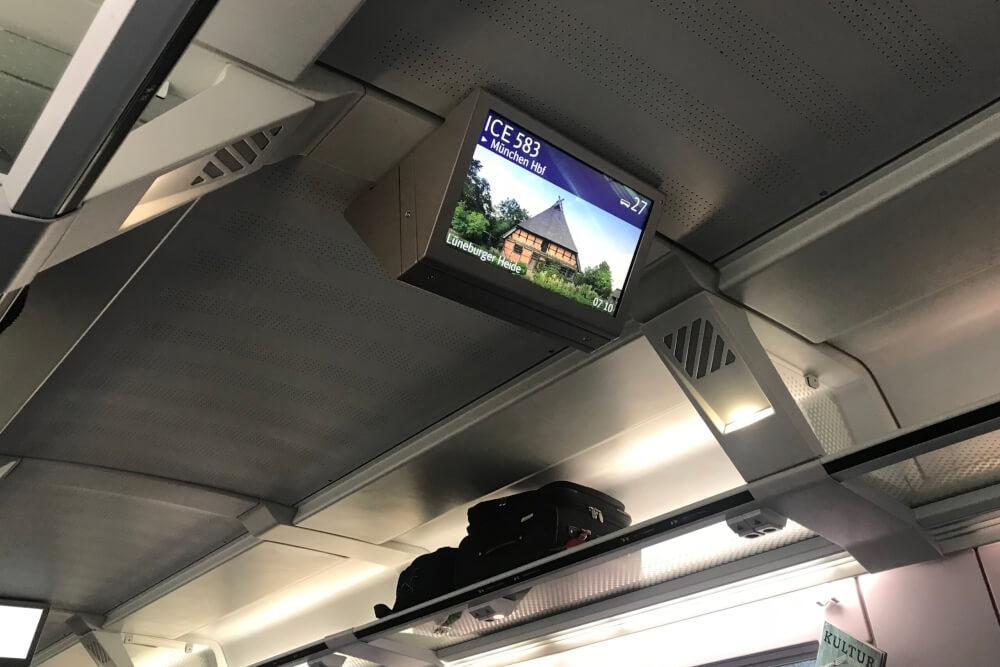
On-board restaurant or bistro: You’ll find these on long distance trains, and if you sit in first class, there’s often even table service straight to your seat.

Bathrooms: And of course, don’t forget to look for the on-board bathrooms (which are free). They’re typically marked by signs saying “WC”.
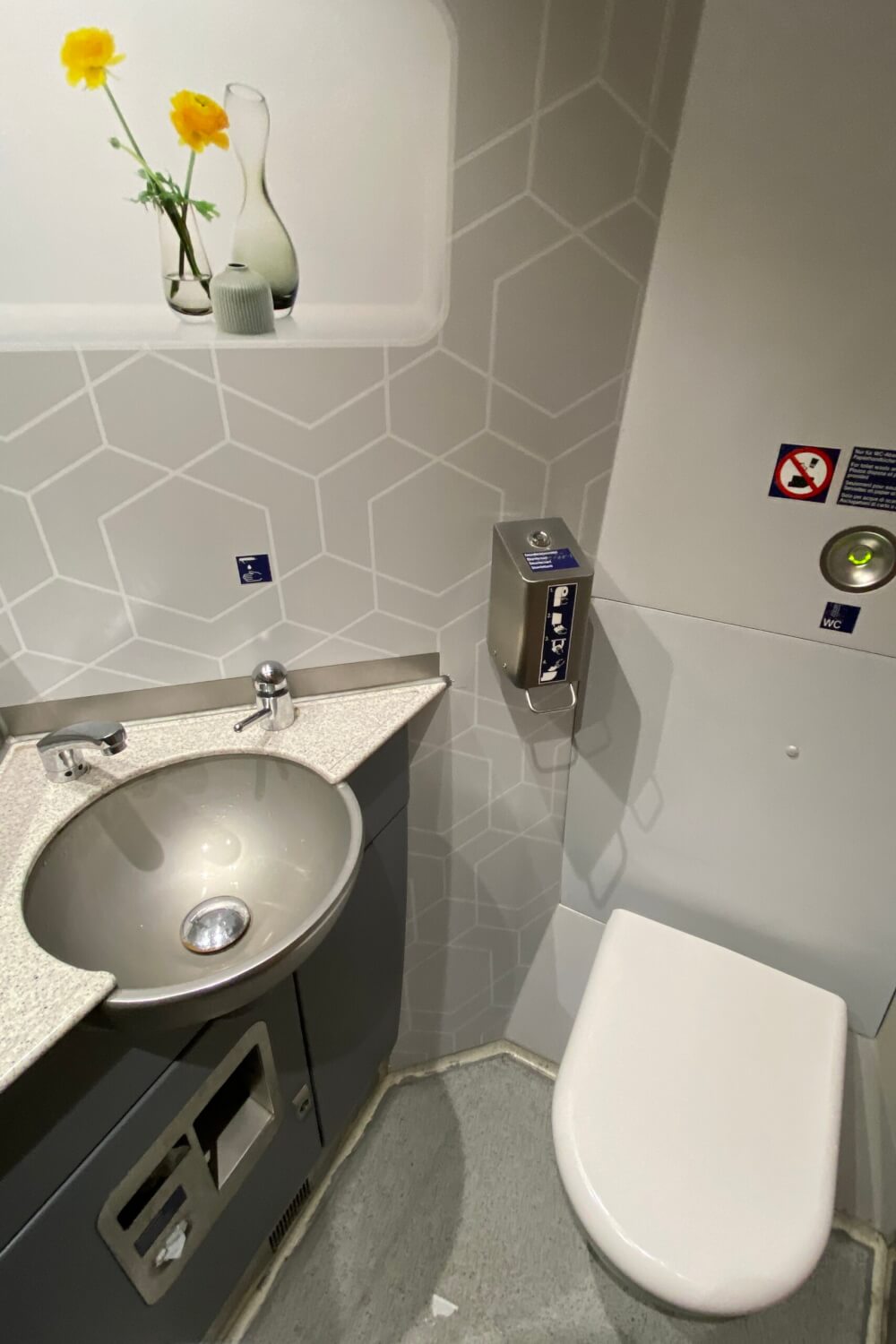
Now, as you get comfy, keep your ticket and ID handy in case controllers come on board. With long distance trains, you’re often able to check yourself in on the app so you don’t have to worry.
Otherwise, you just wait for a controller to come, at which point you show your ticket.
Getting your tickets checked by a controller tends to happen more often in high speed or long distance trains than the regional ones, but regardless just make sure you have your ticket and also some ID (preferably your passport) on you.
Sometimes they will want to verify your name if it’s a reserved ticket, and your age/residency as well depending on whether or not you’ve purchased a discounted fare.
I’ve had it before where they didn’t accept foreign IDs like driver’s licenses – only passports, so that’s why I’d recommend having that.
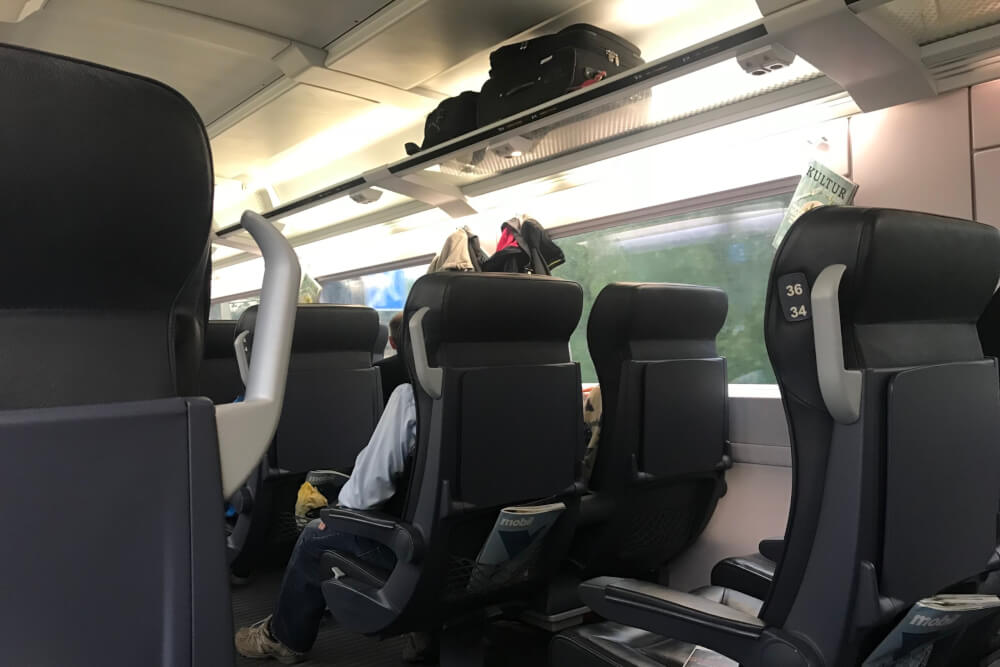
Now after your journey is complete, it’s onto…
Step Nine: Disembark
If you are not getting off at the end destination, then start prepping for disembarkation about 10 min before your arrival time. This gives you plenty of time to gather your belongings and bags in a rational, non-crazed manner.
To keep track of what time you’ll be arriving, keep an eye out for screens that show the scheduled arrival time/estimated arrival time.
Make sure you memorize the name of the stop you’re meant to get off at because most major German cities have multiple train stations and it gets a little confusing once you’re in the city. Like in Munich, you could accidentally get off at the East station instead of the Central Station, just because the names start the same.
And if you’re transferring onto another train, keep an eye out on signs/listen for announcements just before your arrive at your station because they will usually tell you which platforms to transfer on, and if there are any delays/disruptions for transfers.
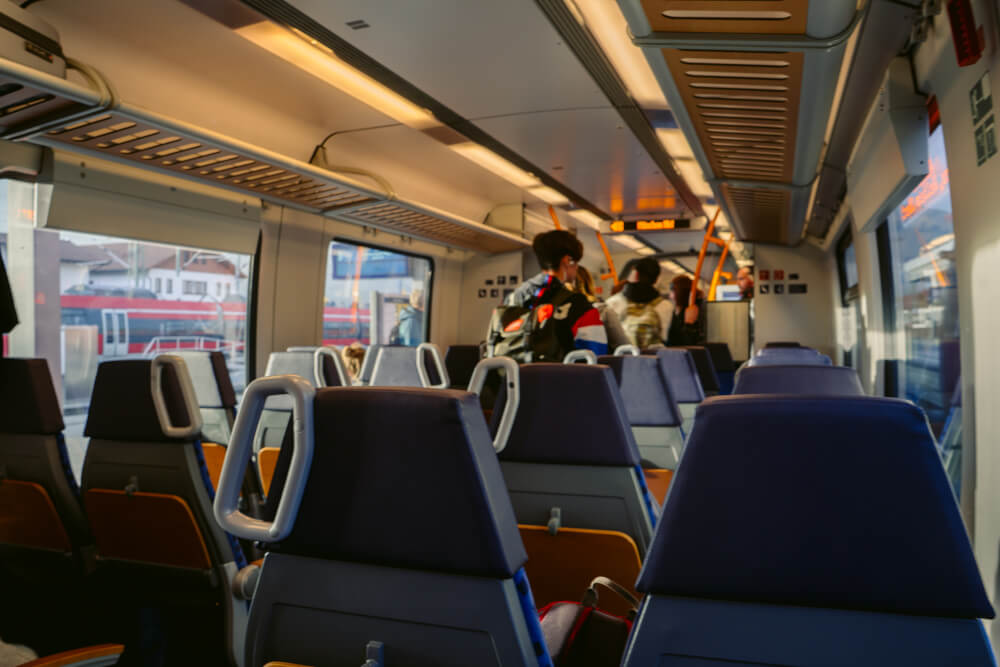
Upon arrival, if the door isn’t opening then again look for a button with the <> open symbol.
Once the doors are open, be careful getting off the train as there’s often a gap/step.
To navigate your way off the platform and onwards to wherever you need to go, keep an eye out for signs that will point you in the right direction.
If you are transferring onto another train, look around for big signs pointing to different platform numbers. If it’s a tight connection (10 min or less) you may want to speed walk or run, depending on how big the station is.
NOTE: Remember, you’re on a train platform, so to reach other platforms you need to either go via a tunnel underground or sometimes a bridge above ground. Keep an eye out for stairs/an elevator so you’re not panicking to find ways to reach your next platform.
If this is your final destination but you need a place to drop off your bags while you explore, most major train stations will have a paid left luggage area with lockers, which is great if you’re too early to check in to your accommodation, or just dropping in for the day.
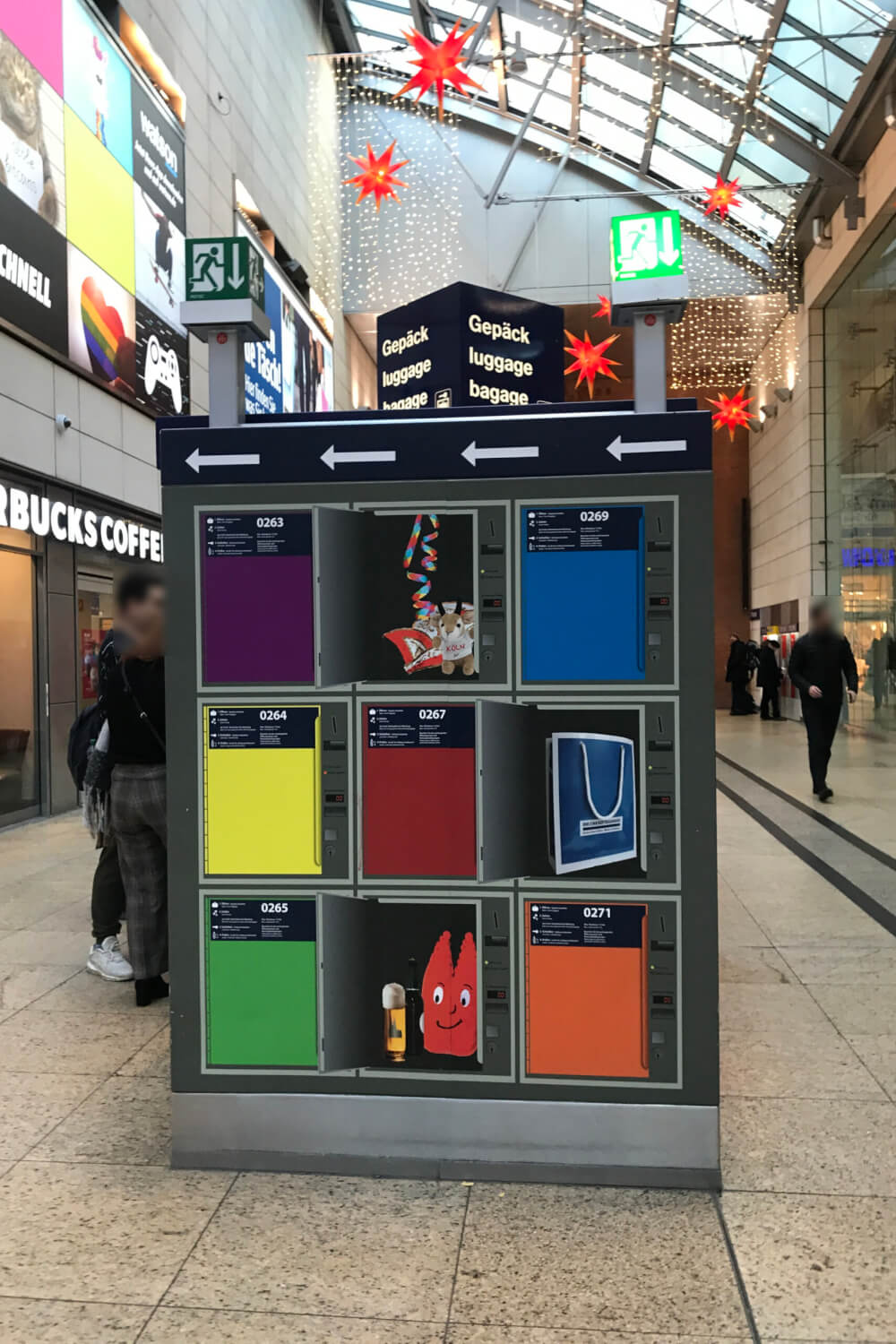
Remember that your train ticket is usually only valid for that specific train you boarded, so you won’t be able to use it for onward travel on the metro or bus unless you bought a special regional ticket or a City Ticket add-on.
Lastly, take note that in Germany, if the train is more than an hour delayed, you are entitled to compensation. Just make sure you get some proof of the delay, whether through an employee or through photos of signs showing the delay. You can then fill out a form or claim compensation through your DB app.
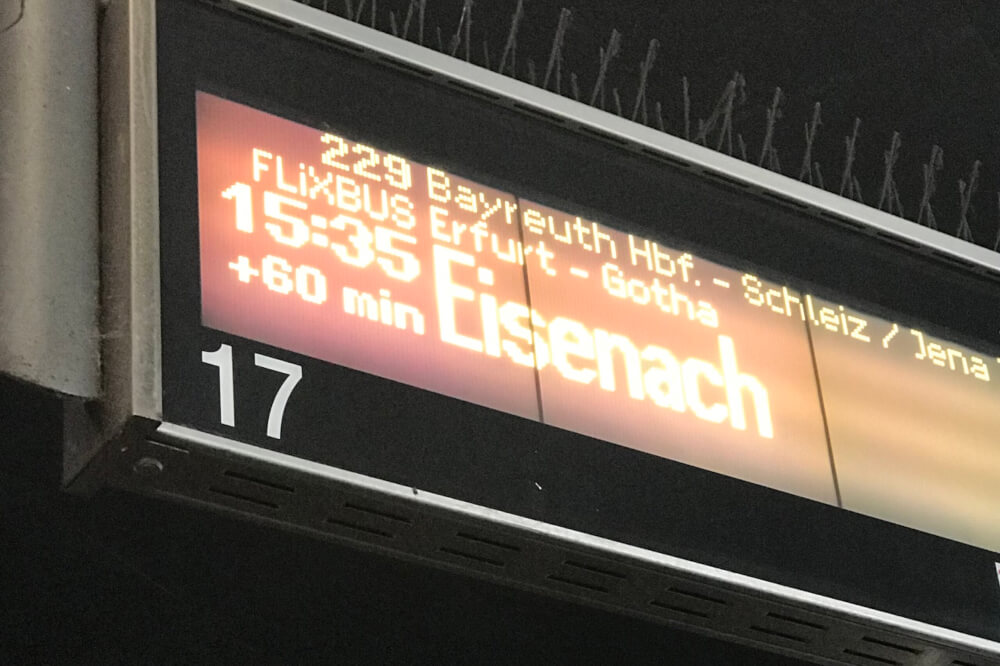
Final Tips for Taking the Train in Germany
Alright, we’ve gone through ALL the basics so now I’m going to simply leave you with some extra bonus tips on how to make the most of the German rail system!
Learn basic train-related vocabulary
The German rail system is very English-friendly for the most part, with many trains making announcements in English and most train attendants speaking at least some English as well.
That said, when you’re in a panicked state dealing with travel stress, sometimes it IS helpful to know some basic words, so here are a few to keep in mind that may be useful:
- Bahnhof: Train Station
- Hauptbahnhof (HBF): Central Train Station
- Gleis: Platform
- Zug: Train
- Abfaht: Departure
- Ziel: Destination
- Einsteigen: To board
- Aussteigen: To disembark
- Umsteigen: To change/transfer
- Zurückbleiben – To stand/stay back
- Endstation: Final stop
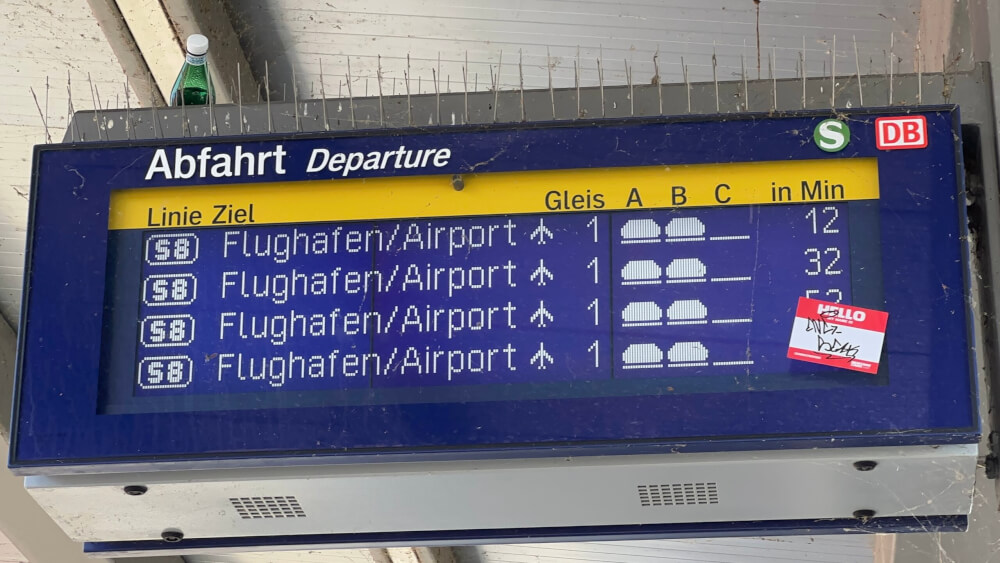
Download the DB Navigator App
I’ve said it so many times already, but the DB Navigator App is an amazing tool, and well worth downloading even if you’re only taking a few trips.
Google Maps does sync train info but it’s sometimes inaccurate or incomplete. The DB Navigator app is free and simple to use, plus it unlocks a bunch of bonus perks like self check-in. Highly recommend!

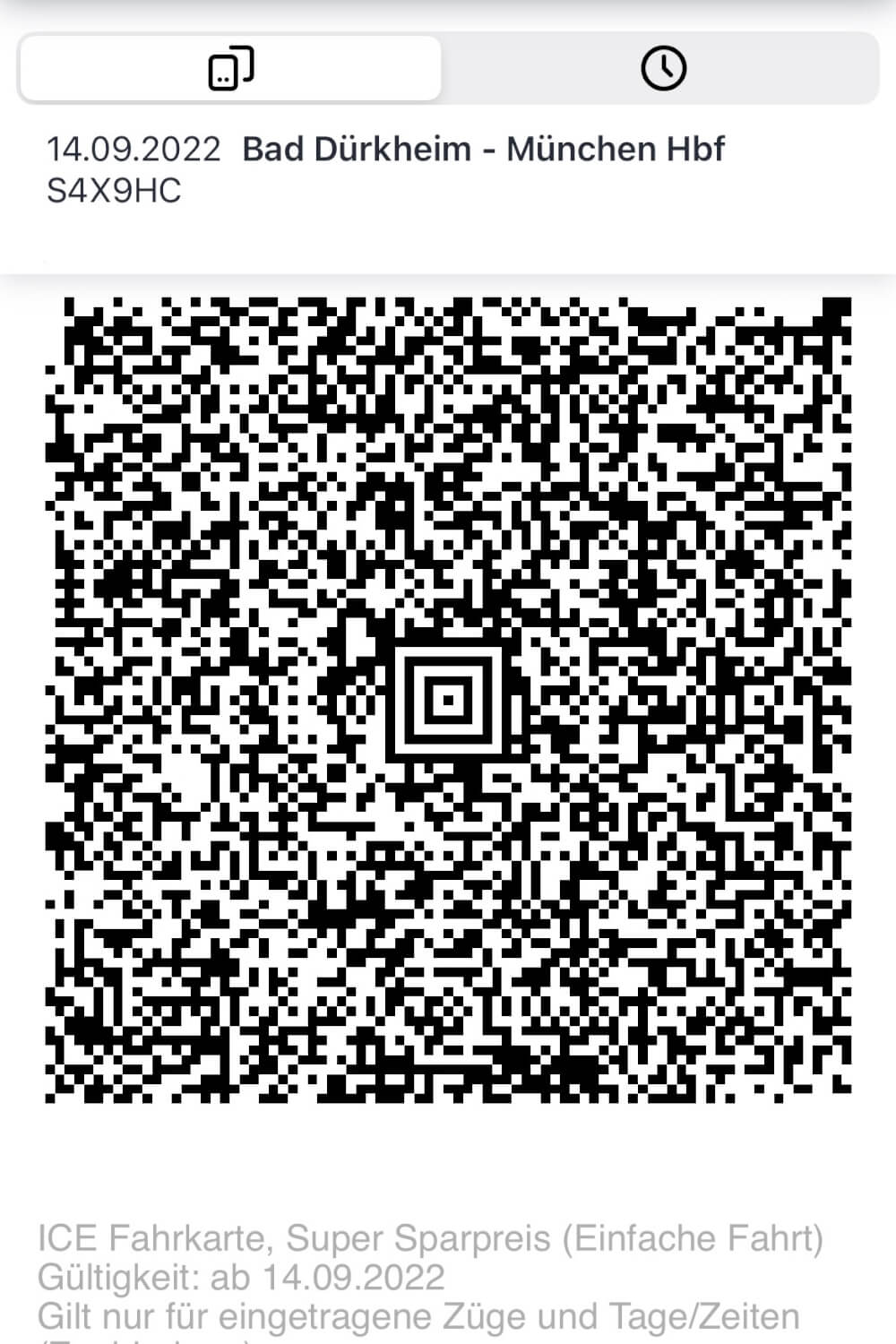
Make use of helpful search filters to find the right train
If you’re struggling to choose which trains to get, then the good news is there are many helpful tools built into the DB website/app.
If you’re travelling exclusively with a Regional Ticket or Deutschland-Ticket for instance, it may be helpful to click on “Mode of Transport” and then set it to “Local Transport Only” which will then filter out high speed trains and show you only the trains you can take with one of those tickets.
You can also ask them to only show the fastest connections, direct services only, trains with a minimum transfer time, or even specify what stopovers you want.
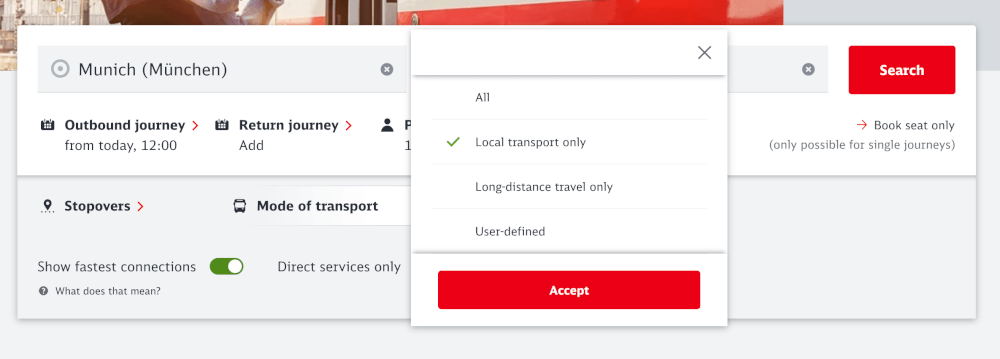
Avoid peak times
As a tourist, you have the luxury of flexibility, so try to plan your train trips around when other people aren’t travelling.
This will ensure the least stressful experience, and make sure you have room for you and your bags.
Some times to avoid include:
- Early morning (to avoid business travellers)
- 3-4pm during school days
- Early evenings just after work (again, to avoid business travellers)
- Weekends (Friday & Sunday evenings, plus Saturday & Sunday mornings especially)
- Holidays
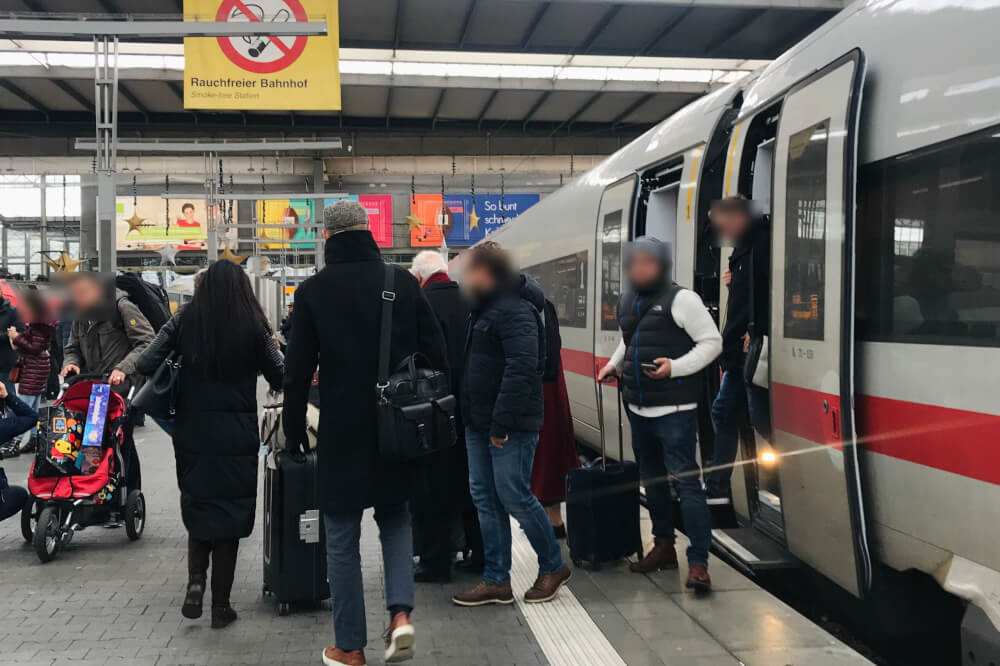
Use the bathroom on the train – bathrooms at the station cost money
As I mentioned in my Germany must-knows post, free public restrooms are quite rare in Germany, which means you’ll usually have to cough up 50 cents or more to pee at train stations.
NOTE: If you do end up using a paid train station toilet, usually the machine will print you a little coupon to use on a future purchase, so if you need to go, head to the toilet first before buying your train station snack.
Luckily, trains on board are free! So take care of business before disembarking.

Don’t forget ID
Again, remember to have ID on you, even if it’s just a little day trip. Sometimes they will ask to see it.
NOTE: You might assume a driver’s license is okay, but I’ve had several instances where they’ve insisted on a passport because they don’t recognize foreign IDs.
It kind of depends on who checks you and how cranky they’re feeling that day, but if you’re from outside the EU, it’s a safer bet to just bring your passport… especially because it’s Germany, and your train might accidentally cross into Austria or something without you noticing.
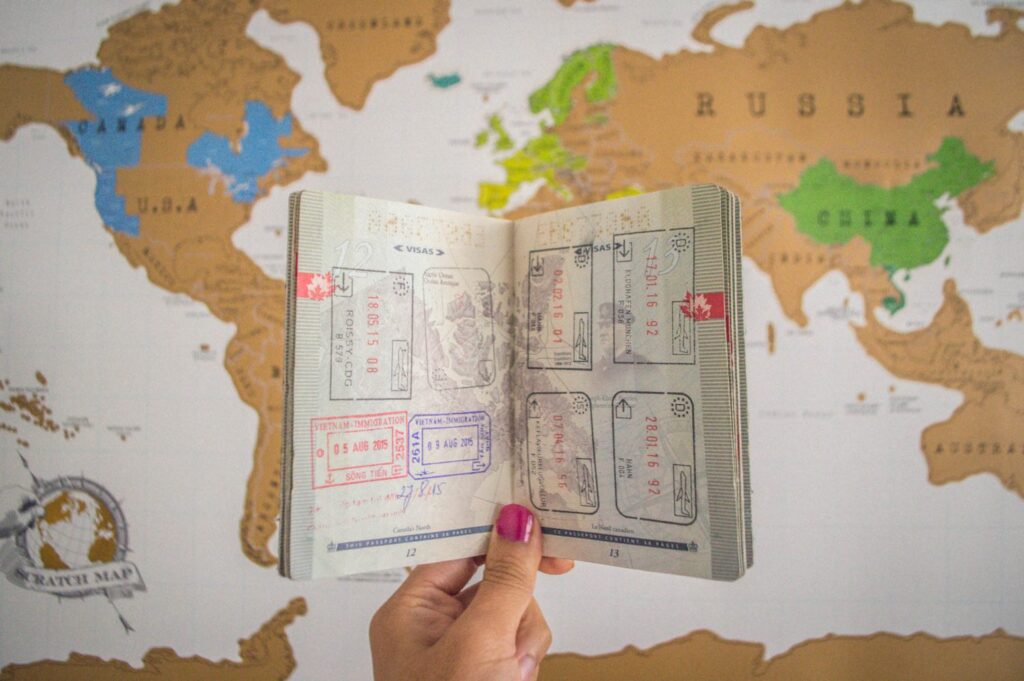
Beware of putting your bag in places you’re not supposed to
One time, I had a suitcase that was too huge and heavy to put in the overhead compartment, so I left it in the bike zone as no one was using it.
About an hour later, a cyclist got on and shouted at the top of his lungs “WHO IS THE HUMAN TRASHBUCKET THAT LEFT THIS SUITCASE HERE?” (Okay, just kidding – my German is bad and he probably didn’t phrase it like that but his tone did).
I was terrified, and was sitting pretty much right next to the suitcase. I had to meekly say it was mine and had the poor dude next to me try to hoist and cram it up in the overhead shelf.
I still have nightmares about it to this day.
So yes, don’t leave your bags where they’re not meant to be.
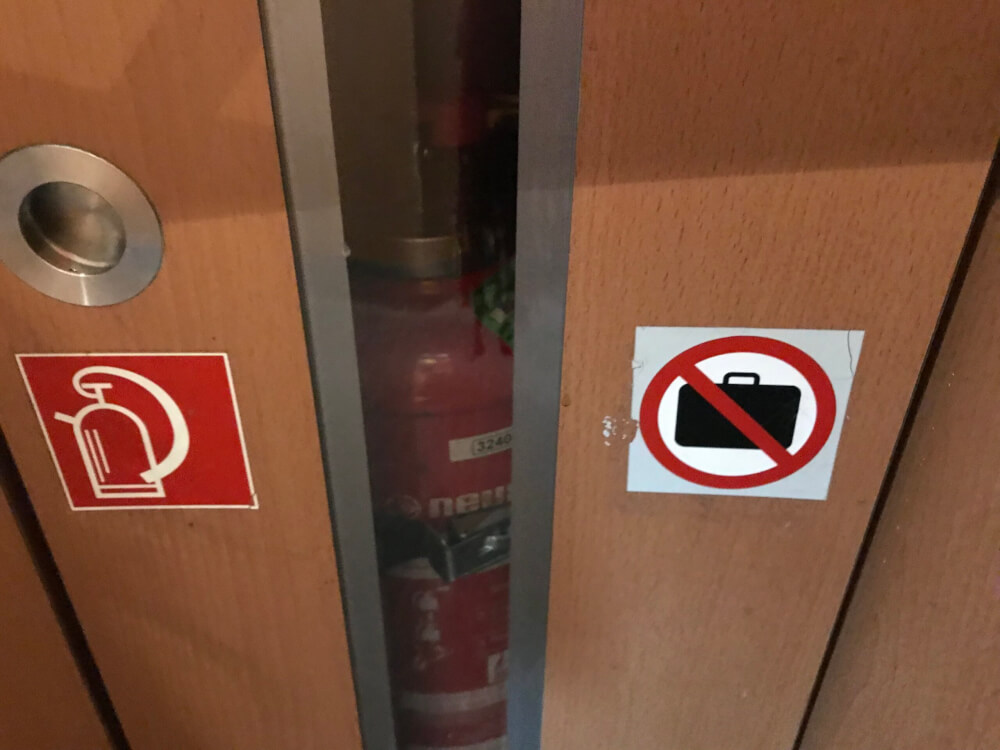
Learn the names of your destinations in German
Most places like Berlin or Frankfurt have the same name as in English, others like Munich (München) or Cologne (Köln) have a different name in German, so make sure you know the German name of your destination, and how to say it in German in case you need to ask for directions.
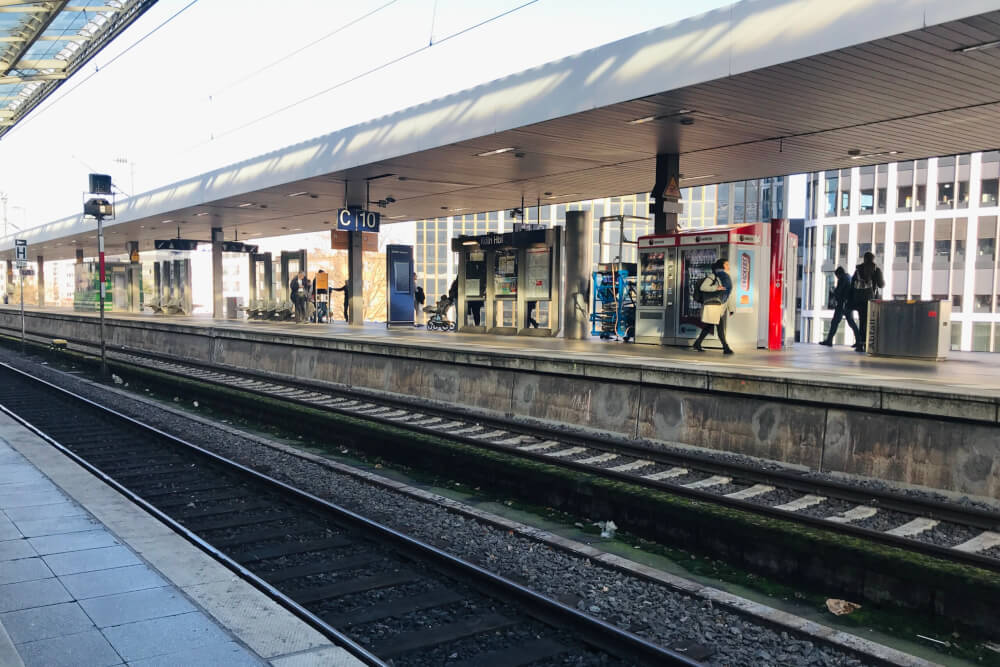
Similarly, learn how to say the names of trains the German way
For instance, ICE trains are not “ice” trains, but rather pronounced Ee Tsay Ay, like the German way of spelling it out.
Be sure to also ask for the U-Bahn, not the subway or Metro.
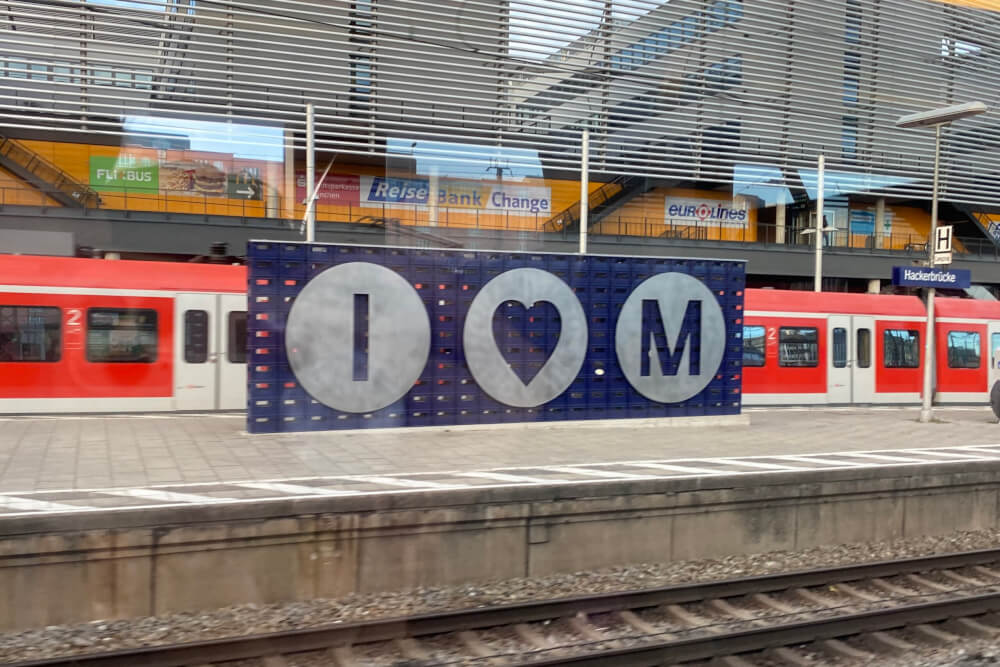
Don’t bank on the WiFi
The WiFi on German trains is hilariously bad considering how much you pay for those tickets… but yes, don’t rely on having WiFi (like setting aside a bunch of work to do on the train that requires it).
Cell service tends to be quite poor as well once you’re away from the big cities.
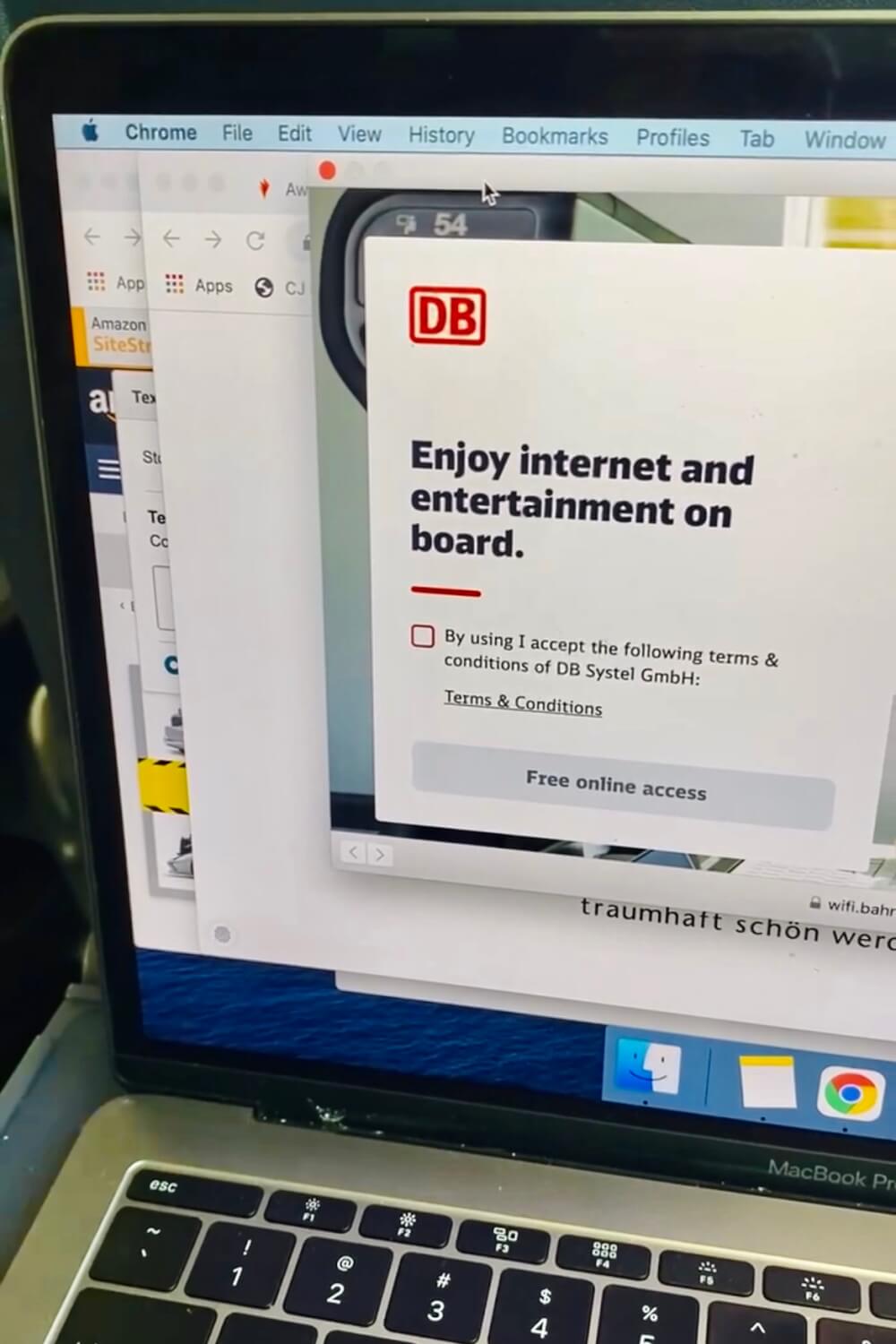
Know your route and stops
The last thing you want to do when travelling by train in Germany is relying solely on the announcements to know when to get off or what to do.
Seriously, mumbling seems to be a skill requirement for workers of DB. Mixed in with ambient train noise and the screeching of rails, I have had it far too many times where I’ve been unable to hear anything the conductor is saying.
They also seem to randomly translate in English when they feel like it, so a translation isn’t guaranteed if you don’t speak German. So, make sure you know your route and approximately when you’ll need to get off, transfer, etc.
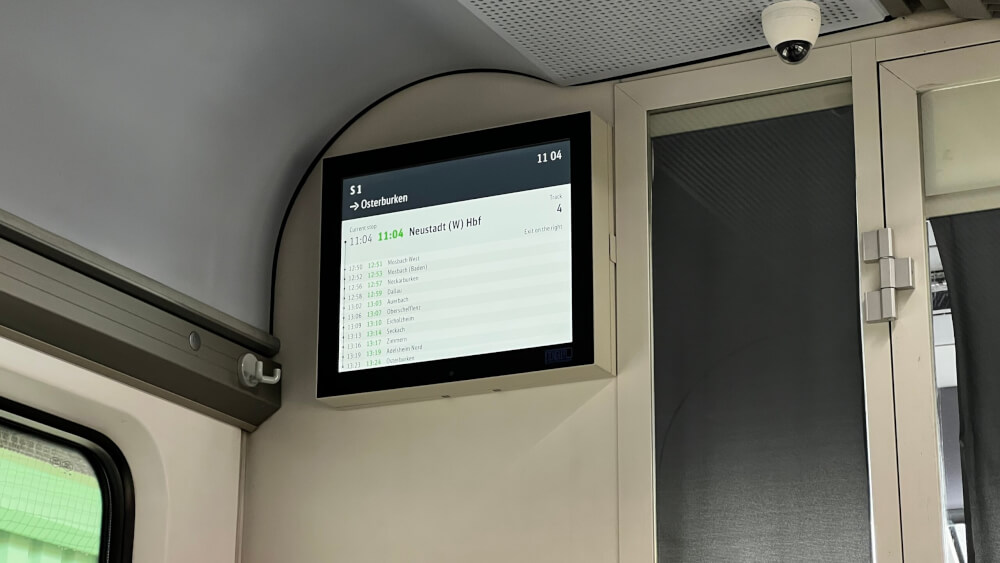
Beware of “on demand stops” where you must press a button for the train to make your stop
Very rarely, you may come across stops that only stop when someone requests it. These are known as Bedarfshaltestellen.
This shouldn’t be a concern unless you’re travelling to very small, quiet stations, so I wouldn’t worry too much, but if you notice anything on your ticket that mentions the word “Bedarfshalt” or any signs that say “”Der Zug hält nur bei bedarf” (the train only stops on demand) then be prepared to press a special button before your stop, kind of like on a bus.
If you are boarding at one of these Bedarfshaltestelle, then don’t worry – the train will stop so long as they see you on the platform.
I had this (stressful) experience when I travelled to Untergrainau:
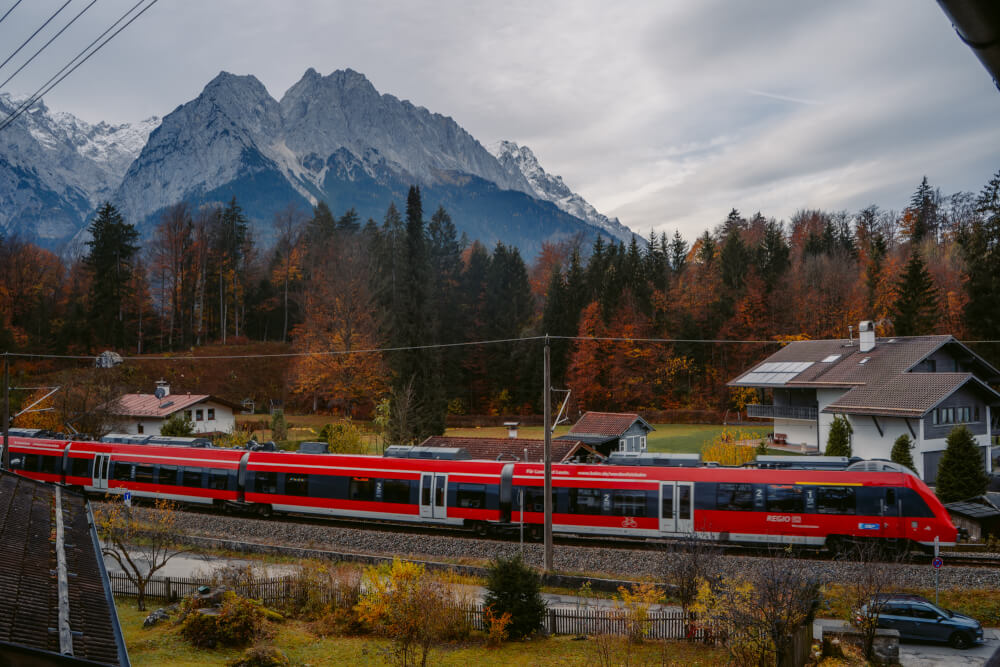
Always read the fine print
Lastly, especially when buying discounted offers for German trains, be sure to read the fine print!
With regional tickets for instance, it’s very common for there to be time restrictions on when the ticket is valid, or when it expires.
Likewise, there’s often restrictions on which types of trains you can take with your ticket, so be sure to read up on these or you may be fined as your ticket will be considered invalid.
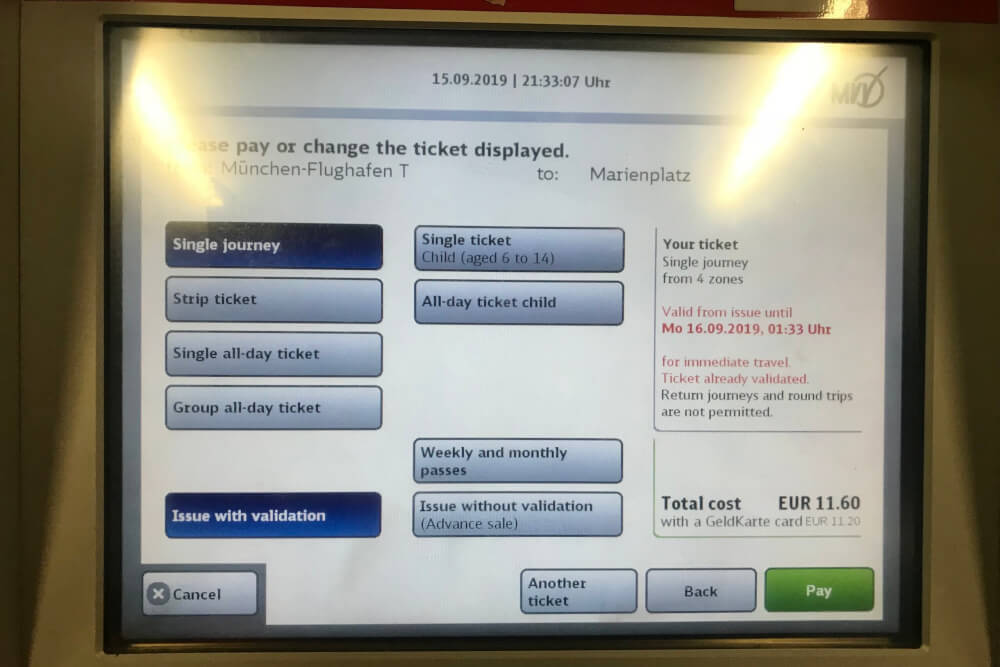
I Hope This Step by Step Guide on Taking Trains in Germany was Helpful!
Let me know in the comments if you have any more questions.


Thank you so much for putting this post together. This was extremely helpful for planning some train travel in Germany. The information is really clear and the pictures are super helpful.
So glad you found it helpful!! Safe travels 🙂